The best thing about the project vehicles we have at 4X4 Australia is working with the amazing aftermarket businesses that contribute and supply the gear to make them special.
In 2025 we’ve built up a couple of special 4x4s – the BYD Shark and the LandCruiser 79 Series – fitting them with top-notch gear to create better off-road touring vehicles.
We had a specific target for these builds, with both set to tackle a Simpson Desert drive, and we wanted to make sure they were up to the task. The PHEV Shark in particular was a bit of an unknown quantity, so we ensured we had the back-up needed to get it across the desert – hopefully under its own steam, but with help on hand if required.
Thanks to our amazing suppliers and drivers, both vehicles crossed the Simpson relatively unscathed, and the corresponding video below is well worth a watch 👇
With many of these suppliers in town for the Melbourne 4×4 Show – and conditions in the mountains perfect for an alpine drive – we invited them to join us for a couple of days of off-road touring in the hills.
Not everyone could make it, but we welcomed crews from Ironman 4×4, Marks 4WD, Evakool, MSA 4×4, Terrain Tamer, Piranha Offroad and Slattery Auctions. Of course, not all of the suppliers involved in the vehicles could join the trip, but it was a great crew and a manageable number of rigs to convoy over the mountains.
We based ourselves at the foot of the mountains in Mansfield, specifically at the Buller Road Brewery, where Adam from the brewery offered to lead our convoy over Mt Skene in the hope of scoring some snow-driving experience. The group was a mixed bag of vehicles with varying capability, so that had to be taken into consideration – not all of them were up to following Adam’s portal-equipped LandCruiser wherever it could go.
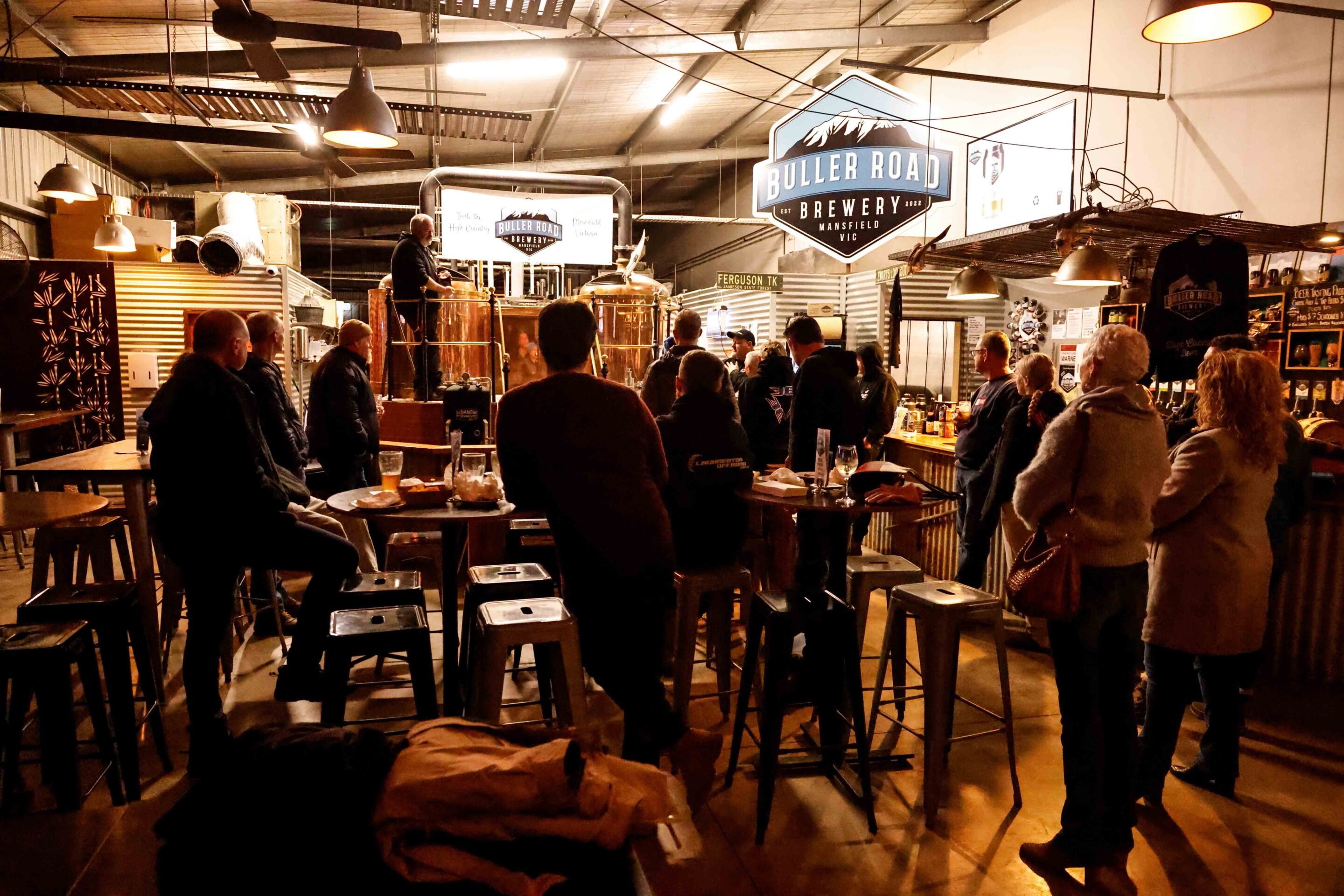
The Jamieson-Licola Road takes you up over Mt Skene, and it’s one of the few places in the High Country where you can find a good snow drive, with most other high-altitude tracks closed for winter. The road over Mt Skene is also closed, but you can drive it with a permit from 4WD Victoria, and with permits for each of our vehicles we headed up the hill.
It’s a long climb up the road from the hamlet of Jamieson, and in a few places we had to negotiate around fallen trees or break out the chainsaw to clear the way. Soon enough we were seeing patches of snow on the sides of the track, growing ever larger as we neared the summit.
Unlike the last time we attempted a convoy over Skene – when the snow was so deep it eventually turned us back – there was relatively little fresh snow on the summit this time. That made for a fun but straightforward drive to the top, where we were able to pull up and grab some pics in and around the patches of snow.
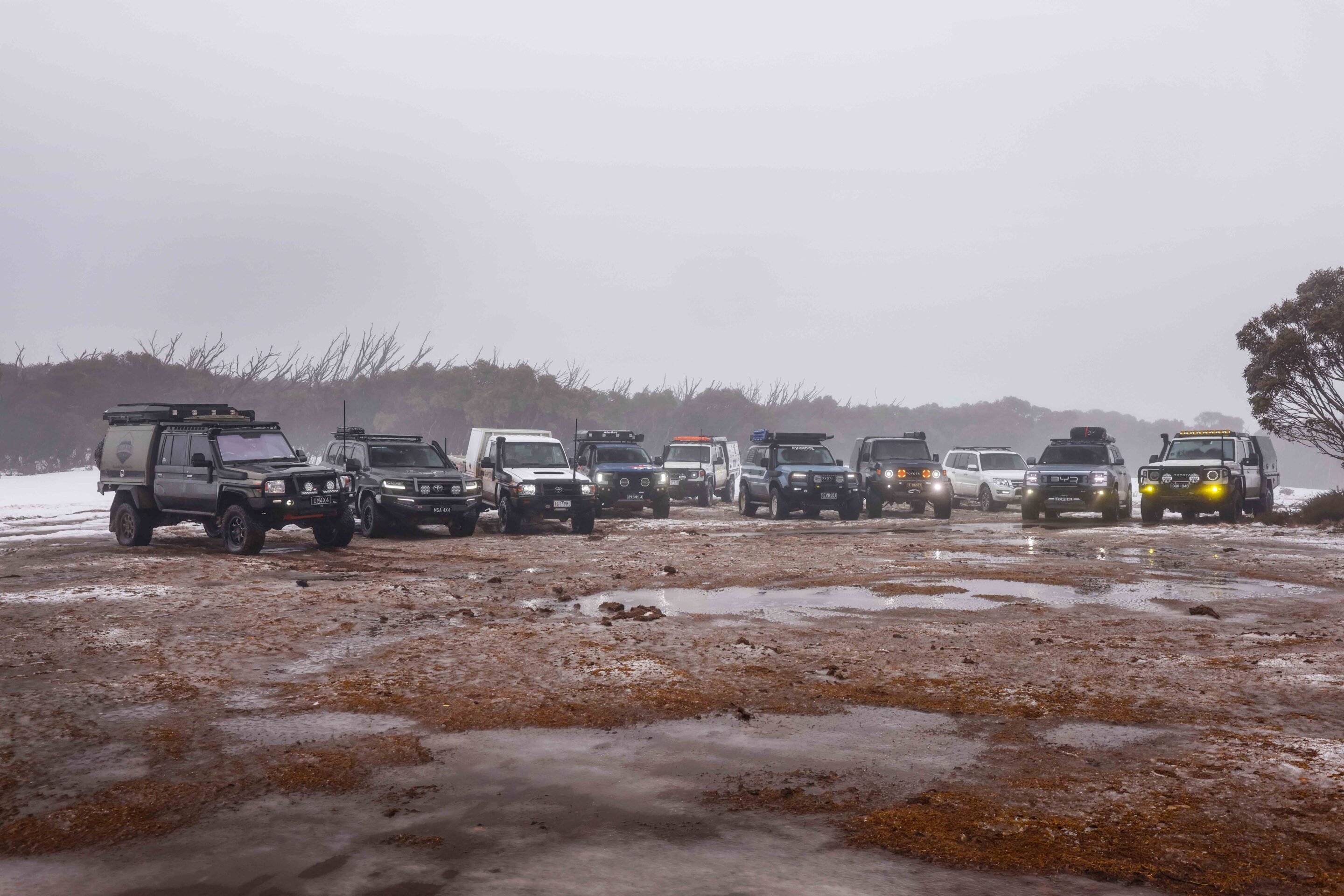
Of course, a cold front rolled through in the following days and dumped plenty more snow in the Alps, but any day wheeling in the mountains beats a day in the office. Soon enough we mounted up and continued on.
In some places, the drive down the mountain was more challenging than the climb up, with trickier terrain to contend with. More fallen trees across the track and wet, slippery descents tested the drivers’ skills on the way down, while a couple of river crossings made for great photographic opportunities.
When we finally emerged on the Woods Point-Jamieson Road, it was still another hour or so back to Mansfield, where we congregated at the Buller Road Brewery for a great night of tasty food and an excellent selection of beers, all brewed on-site.
With Mansfield being the start or finish point for so many 4×4 adventures, the Buller Road Brewery is the perfect stop-off for a feed and a brew – you won’t be disappointed.
While some of the crew had to leave the next morning, Ironman’s Mark Berger led a convoy of the remaining rigs up to Mt Terrible. The run included more epic four-wheel driving, sensational scenery, a touch more snow and plenty of camaraderie.
It’s this camaraderie that makes 4×4 trips so special – visiting amazing places, testing our skills and the ability of our vehicles, and spending time with mates. By the end, you always find yourself planning the next trip.
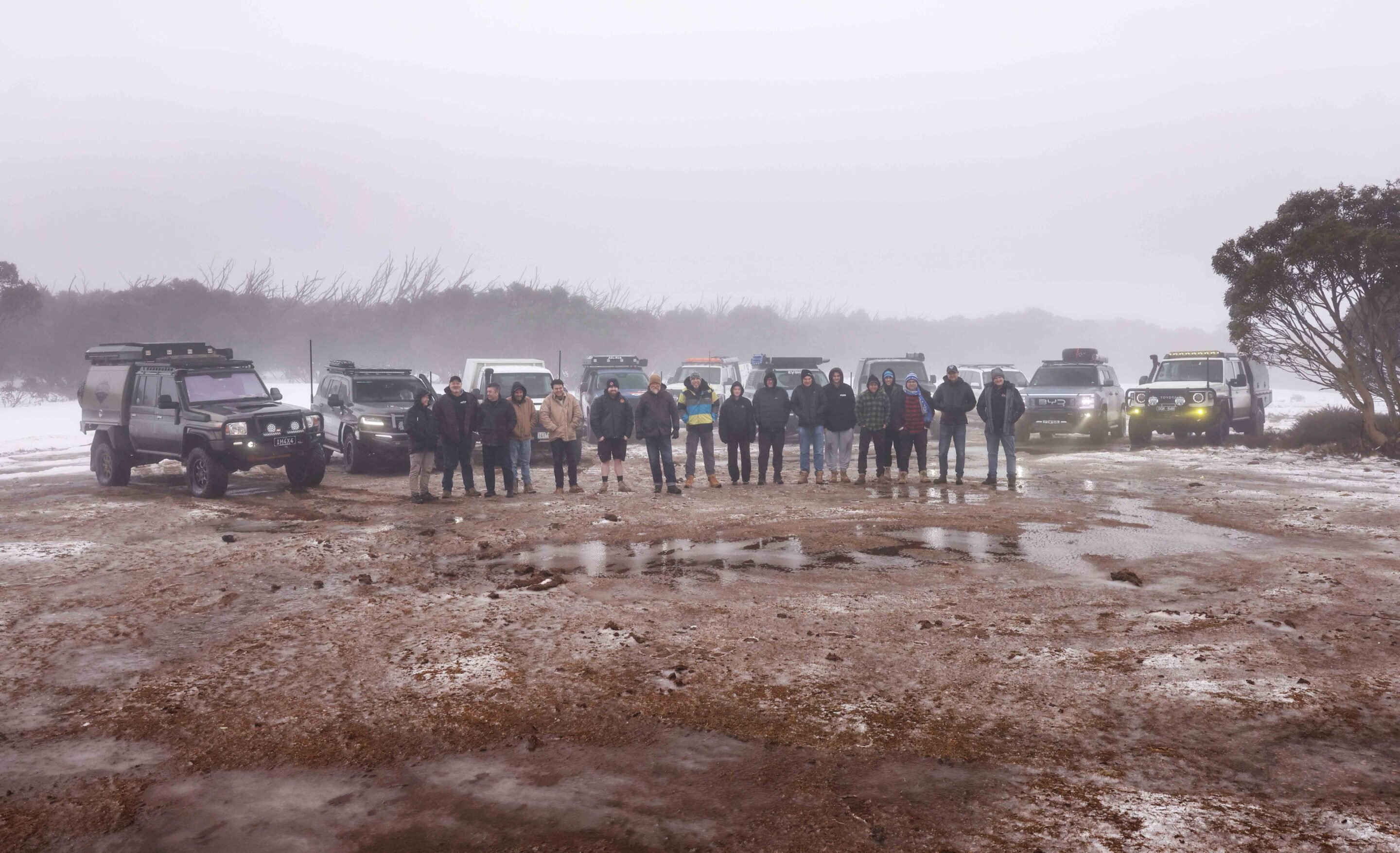
For us at 4X4 Australia, it’s a way of thanking and spending time with those who support our vehicle builds and our publications, in a friendly atmosphere we all enjoy – and one that lets us talk shop without talking business. We thank all of our supporters, especially those who took the time to join us on this adventure.
We’re already planning the next one!
In the market for a new 4×4, or ready to take the plunge into the lifestyle? These are the new and facelifted 4x4s en-route to Australia 👇
JUMP AHEAD
- Next-gen Nissan Navara
- Denza B5 and B8
- Foton Tunland
- LDV eTerron9
- Ford Ranger Super Duty
- Toyota LandCruiser 300 Performance Hybrid
- JAC Hunter PHEV
- Toyota HiLux
- Nissan Patrol
- BYD YangWang U8
2026 Nissan Navara: November 19, 2025
Nissan will unveil the next-generation Navara on 19 November 2025, ahead of its Australian and New Zealand launch in the first half of 2026.
Entering its fifth decade in the region, the new Navara is expected to share its ladder-frame platform with the current Mitsubishi Triton and be built alongside it in Thailand. Diesel engines will continue to power the range, though a plug-in hybrid version is reportedly under consideration. Nissan says the new model draws on feedback from decades of local owners, blending heritage-inspired design with updated technology and capability suited to both work and recreational use.
2025 Denza B5 and B8: November 2025
BYD will launch its premium Denza sub-brand in Australia in November 2025 with two plug-in hybrid SUVs targeting off-road and touring buyers.
The five-seat B5 and three-row B8 both use BYD’s DMO ladder-frame platform with off-road hardware, including locking differentials and adaptive suspension. Local pricing is unconfirmed, though in China the B5 starts around $61,500 and the B8 about $80,600.
The B5 pairs a 1.5‑litre turbo-petrol engine with twin electric motors and a 31.8kWh battery for 505kW and 760Nm, while the B8 uses a 2.0‑litre turbo-petrol plus twin e-motors and a 36.8kWh battery for 550kW and 760Nm. Both claim 0–100km/h in 4.8 seconds, offer multiple off-road modes, and feature high-tech interiors, with the B5 sporting a 15.6-inch rotating display and the B8 a 17.3-inch unit with dual passenger screens and a 50-inch AR head-up display.
2025 Foton Tunland: Late 2025
The Foton ute is set to make a comeback in Australia, with a new line-up of “new energy” and internal combustion engine models confirmed to arrive late in 2025.
While it may not retain the Tunland name, the ute was last seen in Australian dealerships in 2019. Now, with Inchcape as the brand’s new distributor, its return is imminent. However, details about the upcoming models remain under wraps.
In other markets, the 2023 Foton Tunland G7 (short wheelbase) and Tunland V9 (long wheelbase) are powered by a 120kW 2.0-litre four-cylinder turbo-diesel engine, paired with either a six-speed manual or an eight-speed automatic transmission. The V9 also features a 48V mild-hybrid system, although these variants were never available in Australia.
LDV eTerron 9: Late 2025
The all-electric eTerron 9 is set to launch in Australia, while the turbo-diesel Terron 9 is already available locally.
The eTerron 9 offers either a single 200kW rear motor or a dual-motor setup producing a combined 325kW. The Terron 9 is powered by a 2.5‑litre turbo-diesel engine delivering 163.5kW.
Both models share identical dimensions: 5,500 mm long, 1,997 mm wide, 1,860 mm high, with a 3,300 mm wheelbase. Ground clearance is 230 mm for the electric variant and 220 mm for the diesel, and both can tow 3,500 kg braked and 750 kg unbraked. Release dates and pricing for the eTerron 9 are yet to be confirmed.
Ford Ranger Super Duty: Early 2026
Ford Australia will launch the 2026 Ranger Super Duty in early 2026, targeting buyers who need a heavy-duty 4×4 ute capable of competing directly with the 79 Series LandCruiser.
Built for tough industries like mining, forestry and emergency services, the Ranger Super Duty offers a substantial 4500kg gross vehicle mass and towing capacity, along with an 8000kg gross combination mass. This makes it a powerful, ready-to-work option straight from the factory, eliminating the need for aftermarket upgrades. The ute will come in three cab styles, catering to a range of professional and recreational needs. Ford’s introduction of this model reflects a growing demand for factory-built, high-capacity work vehicles that meet stringent performance and durability requirements.
Toyota LandCruiser 300 Performance Hybrid: Early 2026
Toyota has unveiled its first hybrid LandCruiser, with the new 300 Series set to arrive in Australia in the first half of 2026.
It features a 3.5-litre twin-turbo petrol V6 paired with an electric motor in a parallel hybrid setup, making it the most powerful production LandCruiser to date. While final figures are yet to be confirmed, Toyota says the hybrid will offer more power and torque than the current 3.3-litre twin-turbo diesel (227kW/700Nm).
This marks a key step in Toyota’s move towards electrification. Reassuring off-road enthusiasts, Toyota says the hybrid system has been engineered for “true off-road capability and reliability”, with smooth throttle response even in tough terrain. The powertrain has been rigorously tested in extreme conditions, including deserts and mountains in the Middle East.
JAC Hunter PHEV: Early 2026
The JAC Hunter PHEV is set to launch in Australia in the first quarter of 2026.
It made its global debut at the Melbourne Motor Show in April 2025. This plug-in hybrid dual-cab ute features a 2.0-litre turbo petrol engine combined with dual electric motors, producing an impressive 385kW and 1000Nm. For comparison, the BYD Shark delivers 321kW/650Nm, and the Ranger PHEV offers around 207kW/697Nm.
The Hunter uses a lithium iron phosphate battery that provides an electric-only range of at least 100km, and it includes a vehicle-to-load system for powering appliances at campsites. Inside, the cabin resembles the T9 turbo-diesel model, with a 10.4-inch touchscreen and a fully digital 10.25-inch instrument cluster.
BYD Yangwang U8: Early 2026
The luxury plug-in hybrid SUV from BYD’s premium Yangwang sub-brand is expected to launch in Australia by early 2026, with RHD development said to be underway.
The U8 features a quad-motor setup delivering a combined output of up to 880kw, enabling exceptional off-road capabilities and performance. The U8 boasts a 37kWh battery, offering an electric-only range of more than 100km, and includes advanced features such as 360-degree tank turns, crab mode, and the ability to float on water, thanks to its IP68-rated waterproofing. Inside, the cabin is equipped with multiple screens, premium materials, and advanced infotainment systems.
2026 Toyota HiLux: Mid 2026
A new HiLux is expected to land in Australia in 2026, and, with the Ford Ranger dominating the sales charts, it can’t come soon enough for Toyota.
Speculation still surrounds the next-gen Toyota HiLux. Spy shots from Thailand confirmed earlier reports that the HiLux may not be an all-new model but rather a heavily updated version of the current vehicle. Reports also indicate it will retain the ageing IMV platform, with significant changes to the front and rear ends, including a new hood, bumper, grille and headlights.
However, the mid-section will remain largely untouched. The industry is still waiting for confirmation and information from the Japanese marque, but expect electric versions of the venerable ute.
2026 Nissan Patrol: Late 2026
The all-new Y63 Nissan Patrol is scheduled to arrive in Australia in late 2026, with right-hand-drive production set to commence that year.
However, Nissan Australia has indicated that the launch could occur up to six months earlier, depending on demand in other markets. The V8 will be gone, but the upcoming Y63 Nissan Patrol won’t be lacking in power. It will feature two V6 engine options: a 3.5-litre twin-turbo V6 producing 425hp (317kW) and 700Nm, and a naturally aspirated 3.8-litre V6 making 236kW and 386Nm. While it won’t have V8 muscle, the Y63 will become the most powerful factory Patrol ever offered. Early pricing estimates put the Patrol at about $90,000.
Already arrived in Australia 👇
2026 MGU9: OUT NOW!
MG has launched its first dual-cab ute in Australia, the MGU9, priced from $52,990 for the Explore to $60,990 for the Explore Pro.
Sharing a platform with the LDV Terron 9, it stands out with a multi-link rear suspension, Turnover End Gate, and optional Electrically Foldable Rear Cabin Access Panel, combining SUV-like comfort with rugged utility. All models use a 2.5-litre turbo-diesel four-cylinder producing 160kW and 520Nm, paired with an eight-speed ZF automatic and BorgWarner 4×4 system.
With 220mm ground clearance, 550mm wading depth, 3,500kg braked towing, and three grades offering features from LED screens to leather seats with massage/ventilation, the MGU9 targets a mix of practicality, off-road capability and premium touches.
Ford Ranger PHEV: OUT NOW!
The Ford Ranger PHEV will join the Australian line-up in mid-2025, with production beginning in South Africa in late-2024.
It features a 2.3-litre turbo-petrol four-cylinder engine combined with a 75kW electric motor and an 11.8kWh battery, offering an electric-only driving range of more than 45km and maintains a towing capacity of 3500kg.
The Ranger PHEV was globally unveiled on September 16, 2024, at the IAA Transportation Show in Hanover, Germany. It will be available in the Wildtrak, Sport, and XLT variants, as well as a new exclusive Stormtrak edition. Deliveries are expected to start in 2025.
2025 Kia Tasman: OUT NOW!
Kia has officially launched its Tasman ute in Australia.
The Australian-spec Tasman is powered by a 2.2-litre diesel engine producing 154 kW and 441 Nm, paired with an eight-speed automatic transmission, allowing a 0–100 km/h sprint in 10.4 seconds. Its suspension features a double-wishbone front and a rigid rear axle with leaf springs, complemented by Kia’s Sensitive Damper Control and Hydraulic Rebound Stop technology. The ute also offers an 800 mm wading depth.
Three trims are on offer: Baseline, X-Line, and X-Pro. The X-Line adds 18-inch alloy wheels with highway and all-terrain tyres, while the X-Pro is geared for off-road use, with 28 mm higher ground clearance (252 mm total), 17-inch all-terrain tyres, an automatic rear Electronic Locking Differential, and an X-Trek mode for low-speed off-road driving.
All-wheel drive is standard on the X-Line and X-Pro, with an optional AWD for the Baseline. AWD variants feature selectable modes for Sand, Mud, Snow, and Rock, enhancing capability across challenging terrains.
2024 Mitsubishi Triton: OUT NOW!
The bigger, bolder and more expensive next-gen Triton launched in 2024, with the popular ute now trading blows with the big hitters of the segment – Ford’s Ranger and Toyota’s HiLux.
Mitsubishi essentially rebuilt the Triton from the ground up, thoroughly reworking everything from the dimensions (bigger in every way), chassis, engine, interior and driving dynamics. Plus, towing capacity finally meets the industry standard of 3500kg.
All Tritons released at launch were powered by a new Mitsubishi-built 2.4-litre twin-turbo DOHC 16V MiVEC diesel, which develops 150kW at 3500rpm and 470Nm from as low as 1500rpm – an increase of 17kW and 40Nm compared to the old model.
2024 Isuzu D-MAX: OUT NOW!
A facelifted D-MAX arrived locally in the first quarter of 2024.
The venerable ute received a new-look front end, updated “triple-armour” LED tail-lights, and minor interior tweaks including an updated infotainment software with much-needed wireless Android Auto connectivity – previously only available with wireless Apple CarPlay.
At the front, the D-MAX now wears redesigned headlights, a new grey or ‘black chrome’ grille, and a new lower bumper with an integrated air vent. Plus, the D-MAX gets new wheel designs, and the flagship X-Terrain gets more aggressive wheel arches. The D-MAX also received a ‘rough terrain mode’ borrowed from the MU-X. The 3.0-litre turbo-diesel engine remains unchanged.
2024 Isuzu MU-X 1.9: OUT NOW!
Isuzu introduced an MU-X with the option of a 1.9-litre turbo-diesel engine that generates 110kW and 350Nm.
The 1.9-litre diesel in the MU-X produces 110kW and 350Nm – down 30Nm and 100Nm compared to the familiar 150kW/450Nm ‘4JJ3-TCX’ 3.0-litre four-cylinder turbo-diesel. Available in LS-M and LS-U variants, the new powertrain sees the MU-X’s entry price fall $1500.
2025 Isuzu MU-X facelift: OUT NOW!
The facelifted MU-X landed in Australian showrooms early in 2025.
The updates largely mirror the changes made to the facelifted D-MAX, which includes a revised front end with a larger grille, a new fighter jet-inspired bumper with an air curtain to improve aerodynamics, revised LED headlights, updated tail-lights with a new internal signature, a black connecting strip, and new 18- or 20-inch alloy wheel designs.
On the inside, the MU-X gets new 8- or 9-inch central touchscreens with an updated infotainment system. It also gains USB-C charge ports, physical volume and tuning controls, capacitive shortcut buttons for the media controls, an available 7-inch semi-digital instrument cluster, updated front seat patterns, and traffic jam assist.
2024 Jeep Wrangler: OUT NOW!
An updated Wrangler arrived in Jeep dealerships in the first half of 2024, with the Wrangler’s 209kW/347Nm 3.6-litre ‘Pentastar’ petrol V6 replaced by a 200kW/400Nm 2.0-litre turbo-petrol ‘Hurricane’ four-cylinder.
The revised model also received new tech – most notably a full-floating Dana rear axle on Rubicon models – subtle design changes and improved safety features such as the addition of side curtain airbags in the first and second rows.
A larger 12.3-inch Uconnect 5 widescreen with wireless Apple CarPlay and Android Auto are also implemented. Plus, the Wrangler is available with a new Warn winch from the factory, and an increase in towing capacity to 2268kg.
2024 Toyota LandCruiser Prado: OUT NOW!
The 2025 Toyota LandCruiser Prado has officially launched in Australia, with the all-new SUV boasting a five-model line-up: GX, GXL, VX, Altitude and Kakadu.
The 2.8-litre turbo-diesel four-cylinder engine, assisted by 48-volt V-Active technology, produces peak outputs of 150kW and 500Nm, and it’s mated to a new eight-speed automatic transmission and a full-time all-wheel drive system, dual-range transfer case and a centre lockable limited slip differential.
2024 Lexus GX: OUT NOW!
An upmarket Prado twin is also out now in Australia, marking the first time the Lexus GX is sold in Australia – despite being on sale in the US for more than 20 years.
The GX arrived with a 3.5-litre twin-turbo V6 and 10-speed auto. A 2.4-litre turbo-petrol hybrid is expected to be added to the showroom after the initial launch.
As is the case with the Prado, the GX rides on Toyota’s latest TNGA-F body-on-frame platform. All GX models have full-time all-wheel drive with a low-range transfer case and a locking Torsen limited-slip centre diff.
2024 Ford F-150: OUT NOW!
Ford’s updated version of its best-selling F-150 pick-up landed with Australian customers late in 2024.
The facelifted F-150 receives a new grille and bumpers, as well as LED headlights and tail-lights. A ‘Pro Access’ split tailgate is an option on Lariat variants. While updated on-board tech includes Ford’s latest version of its BlueCruise hands-free driving functionality, as well as an exit warning system that alerts exiting drivers of vehicles and pushbikes.
The Australian line-up is expected to remain with two trim levels – both available in short wheelbase and long wheelbase guise.
2024 BYD Shark 6: OUT NOW!
The BYD Shark 6 is on sale in Australia, sharply priced at $57,900.
The BYD Shark showcases advanced DM-O (dual-mode off-road) technology, combining a 170kW 1.5-litre turbocharged engine with dual electric motors for a total output of 320kW. It offers three terrain modes – Sand, Mud, and Snow – and boasts an estimated range of 800km.
This body-on-frame, four-door ute features a PHEV-designed frame, with a double wishbone front suspension and a similar rear setup. Interior highlights include a 12.8-inch infotainment system, a 10.25-inch digital instrument cluster, a 360-degree camera, wireless charging, and an NFC key card.
2025 INEOS Grenadier Quartermaster: OUT NOW!
The first Grenadier ute, dubbed the Quartermaster, on sale now in Australia.
Much like the Grenadier wagon, the Quartermaster ute features a full box-section ladder frame chassis, heavy duty solid beam axles, a two-speed transfer case, and up to three locking differentials. Unlike the wagon, though, the Quartermaster comes with uncompromising load-carrying ability.
Priced from $105,000 plus on-road costs, the Quartermaster stretches the Grenadier ladder-on-frame chassis wheelbase 305mm to 3227mm – for a total 5400mm length – with a tray able to fit a 1200mm by 800mm European pallet. The Quartermaster is available with either a diesel or petrol powertrain, and both are BMW 3.0-litre turbocharged inline six engines. These are mated to a ZF eight-speed automatic transmission that sends power to all four wheels.
2024 Toyota HiLux 48V: OUT NOW!
Toyota unleashed its facelifted 48V HiLux in the first half of 2024. with the 48-volt mild-hybrid powertrain offered on SR, SR5 and Rogue 4×4 variants.
The mild-hybrid powertrain uses will use an electric generator and lithium battery that provides an additional 12kW and 65Nm – in conjunction with regenerative braking – to the 2.8-litre four-cylinder turbo-diesel engine.
2024 GWM Tank 500: OUT NOW!
With dimensions to compete against the LandCruiser 300 Series, but at a fraction of the price, the GWM Tank 500 adds 100mm in length to the smaller Tank 300 and uses a 3.0-litre turbocharged V6 petrol mild hybrid set up with a nine-speed automatic.
Increasing the appeal of the budget SUV will be a luxurious interior, with the large off-roader getting four sculpted bucket seats, leather upholstery surrounded by brushed-aluminium and woodgrain-look trims.
Despite these lux underpinnings, the Tank 500 is competitively priced at $73,990 (drive-away).
2024 GWM Cannon Alpha: OUT NOW!
GWM has released its Cannon Alpha range, with the Lux turbo-diesel starting at $51,990, the mid-range Ultra turbo-diesel priced from $57,990 and the range-topping Ultra hybrid from $64,990 (all driveaway).
The latter utilises a 2.0-litre turbo-petrol hybrid engine that delivers outputs of 255kW and 648Nm, marking the Cannon Alpha as the first ute in Australia to be available with a full hybrid powertrain. GWM says the petrol-hybrid engine will consume 9.8L/100km of unleaded.
The two non-hybrid variants are powered by a 2.4-litre turbo-diesel engine that generates 135kW and 480Nm, with an official fuel consumption figure of 8.9L/100km. All vehicles utilise a nine-speed automatic transmission and are coupled with a Torque On Demand (TOD) four-wheel drive system that features a Borg Warner transfer case.
GWM Cannon: OUT NOW!
The smaller sibling to the Cannon Alpha, the Cannon, arrived early in 2025 with the same 135kW/480Nm 2.4-litre turbo-diesel engine and 3500kg towing capacity.
The Cannon features revised exterior styling consisting of a new grille and lower front bumper, and a new wheel design. Plus, an overhauled interior includes a reconfigured dash with a larger infotainment touchscreen and digital instrument cluster. The Cannon also adopts the gear shift lever as found in the GWM Tank.
GMC Yukon Denali: OUT NOW!
GMC has launched its large Yukon SUV in Australia.
Only one variant is available to purchase in Australia – the Yukon Denali – and it is equipped with a mountain of premium products, headlined of course by the same powertrain which drives the Silverado 1500: a 313kW/642Nm 6.2-litre V8 petrol engine, mated to a 10-speed automatic transmission.
Inside, the SUV is outfitted with a 16.8-inch infotainment touchscreen, a panoramic sunroof, a head-up display, and Bose speakers embedded in the headrests. The second row offers a premium experience as well, with captain’s chairs featuring the same leather upholstery and headrest speakers. The right-hand drive conversion will be handled by the Walkinshaw Group.
JAC T9: OUT NOW!
The affordable faction of the popular dual-cab ute segment has expanded with another Chinese newcomer.
The JAC T9 is available in two variants, a base-spec Oasis ($42,662 before on-road costs) and a top-of-the-range Haven ($45,630). The T9 is powered by a 125kW/410Nm 2.0-litre single-turbo four-cylinder diesel engine matched to an eight-speed automatic and part-time four-wheel-drive system.
The JAC T9 comes with a 3000kg towing capacity; a 76-litre fuel tank; and a suite of active safety technology. JAC has also confirmed an all-electric T9 will arrive in Australia in the future, and all JAC models will be covered by a seven-year/unlimited-kilometre warranty. ANCAP has awarded the JAC T9 dual-cab ute full safety marks in August 2024, with the five-star score applying to all 2.0-litre diesel variants sold in Australia.
Toyota Tundra: OUT NOW!
Toyota Australia has confirmed the 2025 Tundra full-size pick-up is now in local dealerships.
After a nine-month evaluation involving 300 leased vehicles, the Tundra is imported from the USA in left-hand-drive configuration and converted to right-hand-drive by the Walkinshaw Group in Melbourne. This marks the first instance globally where Toyota has authorised such a program.
The Tundra is built on Toyota’s TNGA-F platform, shared with the LandCruiser 300 Series, allowing the use of some LC300 components in the conversion process. It is powered by a 3.5-litre twin-turbo V6 engine generating 326kW and 790Nm, coupled with a 10-speed automatic transmission and part-time dual-range transfer case, offering a towing capacity of 4500kg and a payload of 758kg. Pricing starts at an eye-watering $155,990.
2025 Mazda BT-50 (facelift): OUT NOW!
Mazda has released the 2025 BT-50, with the facelifted model now in dealerships across Australia.
Key exterior updates include new LED headlights, an enlarged logo on the grille, revised bumpers, fresh alloy wheels, and redesigned tail-lights. Inside, the BT-50 features a new nine-inch infotainment system with wireless Android Auto and Apple CarPlay, retaining tactile controls for volume and climate. The driver display has also been upgraded.
New Advanced Driver Assistance Systems (ADAS) include improved cameras, Traffic Jam Assist, and enhanced automatic emergency braking for pedestrians and motorcyclists. More information and pricing will be revealed closer to its launch in 2025.
Isuzu D-MAX Blade: OUT NOW!
Isuzu has a new flagship model sitting atop its D-MAX model line-up, with the Walkinshaw-fettled D-MAX Blade landing in dealerships from November 1, 2024.
The all-new Blade launched with a price of $76,990 drive-away – IUA says this is a special introductory price, so expect that to rise in 2025. That price tag means it only costs marginally more than the former flagship D-MAX X-Terrain (at $70,500 before on-road costs), and despite no change to the powertrain there’s plenty of Walkinshaw treatment included.
Nissan is set to reveal the next-generation Navara globally on November 19, 2025, with Australian and New Zealand sales expected in the first half of 2026.
The launch will mark the start of the Navara’s fifth decade in the region. Since its debut in Australia in December 1986, the Navara has sold more than 420,000 units, earning a reputation as a reliable workhorse for trades, farmers and weekend adventurers alike.
“For nearly 40 years, Navara has been writing its story alongside Australia’s own evolution,” said Andrew Humberstone, Managing Director, Nissan Oceania. “Every generation has learned from the previous one, and every Australian customer has taught us something about what matters most in a ute.”
Ahead of the reveal, Nissan released a heritage film (above) highlighting four decades of the ute in Australian life – from early mornings on job sites to boating trips and family outings. The film demonstrates how the Navara has adapted to local conditions and customer needs over the years.
The new Navara is reported to use a ladder-frame chassis shared with the current Mitsubishi Triton, with both utes assembled at the same plant in Thailand. This follows the collaboration within the Renault-Nissan-Mitsubishi Alliance.
Engine choices are expected to focus on diesel, following the Triton’s lead, which offers 150kW and 470Nm from a four-cylinder turbo-diesel, coupled with either a six-speed automatic or manual transmission. Reports indicate Nissan is also considering a plug-in hybrid variant for the new Navara.
Full details remain under wraps, but information will no doubt be revealed as we approach the vehicle’s official launch.
When it comes to 4×4 touring in Australia, diesel has long been the fuel of choice.
There are plenty of reasons for this preference: Old carburetted petrol engines in Series Land Rovers, Land Cruiser FJs and G60 Datsuns were prone to vapour lock whenever the mercury climbed towards 40°C, leaving you stranded in the heat; carrying petrol in jerry cans was always riskier than carrying diesel; and diesel delivers greater torque, efficiency and touring range for the same volume of fuel.
In more recent times, the arrival of factory-built turbo-diesel engines delivered even more grunt and improved fuel economy, making them especially appealing to long-distance travellers.
Toyota has long offered LandCruisers with a choice of petrol or diesel powertrains, but as modern diesels improved in both performance and efficiency, the petrol options steadily fell out of favour. The LC200 was the last model sold here with both fuel types, but Toyota Australia eventually dropped the petrol variant due to a lack of demand.
At the time, Toyota was selling eight to 10 times more LandCruisers than Nissan managed with its Y62 Patrols, month after month. The Y62 is a great wagon – I’ve always loved driving it – but being petrol-only, it never came close to matching the Cruiser’s sales.
So it caught my attention when Toyota’s sales and marketing boss, Sean Hanley, said at the reveal of the LC300 Hybrid that he doesn’t see much of a future for diesel in Australia beyond the next decade.
Toyota is hedging its bets on future fuels every which way, with BEV, EV, ICE, hydrogen and hybrids all represented in its showrooms. Hanley says there’s no single perfect fuel for every application, adding: “At Toyota, we are committed to a multi-pathway approach to decarbonisation, providing appropriate powertrains for different applications.”
While the Performance Hybrid petrol LandCruiser is just one of those pathways, there will be many more. Hanley sees hydrogen taking over from diesel as the fuel of choice for heavy vehicles and other applications where diesel has long been king. This would require significant infrastructure to store, transport and deliver the fuel across the country, not to mention changes to the vehicles themselves. Toyota Australia is already investing heavily in this space, but there’s still a long way to go.
I find it hard to believe we’ll see this change within the next 10 years, but there will no doubt be shifts along the way. What I am sure of is that I’ll still be filling my LandCruiser with diesel at remote outposts in outback Australia for the rest of my days.
Isuzu Ute Australia (IUA) recently rolled out a new 2.2-litre engine and eight-speed automatic gearbox, to be offered alongside its proven 3.0-litre ‘4J’ in D-MAX and MU-X models, and we got to drive it.
The long and short of it is that the new Euro 5 RZ4F engine replaces the underwhelming 1.9-litre unit it’s based on, with the redesigned powerplant producing a claimed 120kW/400Nm (up 10kW/50Nm), and it’s backed by a new Aisin-sourced eight-speed auto. It also gets fuel-saving technology like Idle Stop Start (ISS) – but the 3.0-litre now gets that, too.
In listening to its customers, IUA has given the 2.2 models a full 3500kg braked towing capacity, compared to the 3000kg rating that hamstrung the 1.9 models, making the new powertrain as capable as its big brother on paper.
Customers will pay for the new engine and ’box though, with the 2.2-litre models priced around $1500 higher than their 1.9-equipped counterparts, and the price hikes extend to the 3.0-litre models adding between $1500 and $2500 to sticker prices across the range.
The cheapest 4×4 D-MAX is now the SX 3.0 single-cab chassis at $46,200 (up $1500), and the cheapest dual-cab is the SX 2.2 at $50,700, while the entry-level 4×4 MU-X LS-M 2.2 starts at $55,900 (up $1500). The budget manual ’box models are also gone for good, with IUA offering only self-shifters from here on in.
This is the price we’re all paying for the New Vehicle Efficiency Standards (NVES), as manufacturers fight to avoid hefty fines by bringing CO2 emissions down. The new engine spits out 174g of CO2 per kilometre in the D-MAX and 177g/km in the MU-X, so it comes in below the 2025 threshold of 210g/km for light-commercial vehicles. Next year that threshold drops to 180g/km and by 2027 it will drop again to 150g/km, meaning at best this 2.2-litre engine buys IUA a year or two, before it’ll be faced with hefty fines for every vehicle sold.
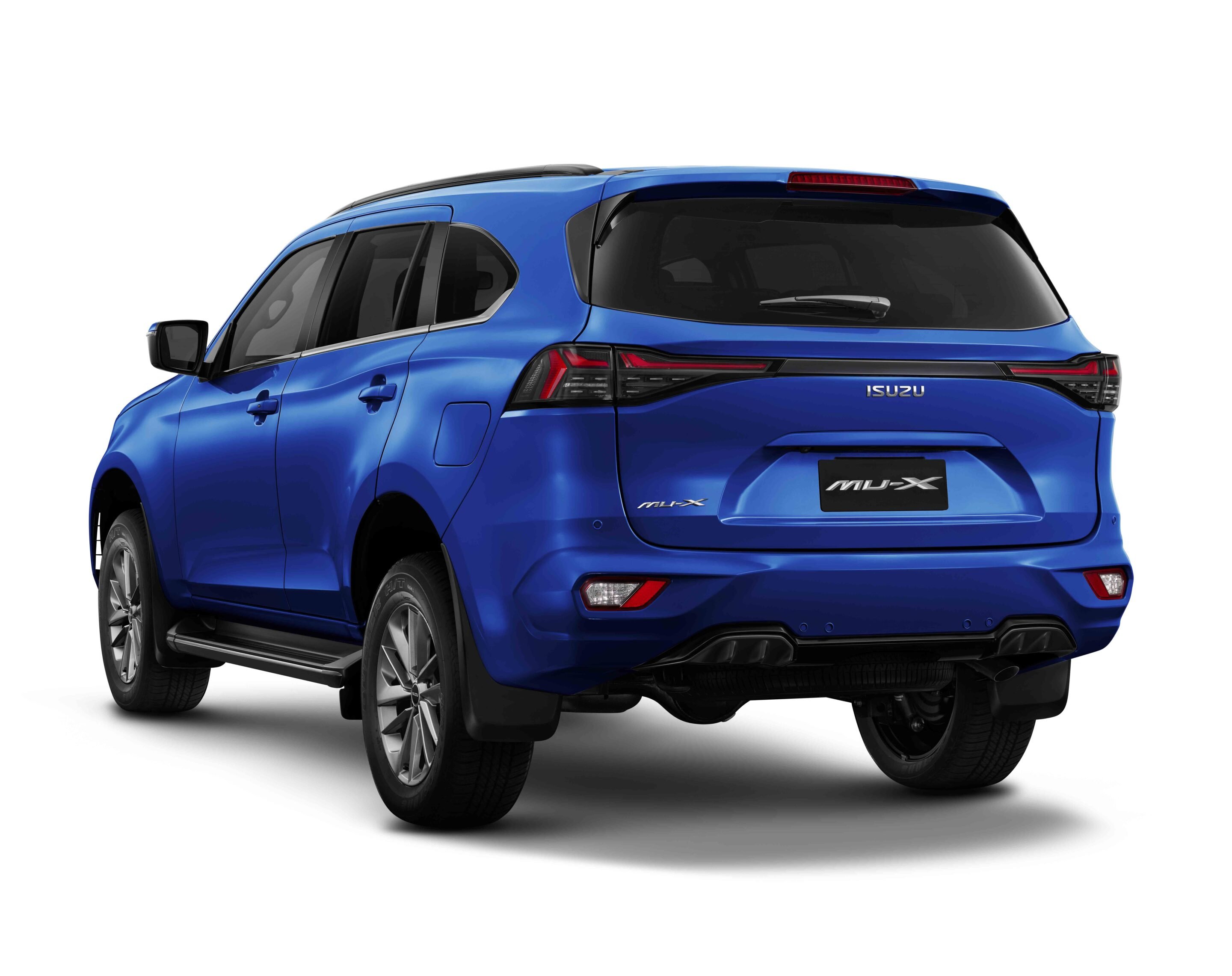
As other brands like Toyota and Ford pursue hybrid technology in a bid to clean up their diesel models, Isuzu appears to have abandoned its mild-hybrid system, which featured – in very limited numbers – on its now-scrapped 1.9-litre engine in Thailand.
We weren’t able to get anyone ‘in the know’ at IUA to confirm or deny the likelihood of a new mild-hybrid system for the 2.2-litre engine, and none would outline whether hybrid technology is planned for the brand’s Australian models in the future. Nor would executives elaborate on the previously announced electric D-MAX model, suggesting that for the foreseeable future none of their models will feature electrified systems of any type.
Then there’s the fact the new 2.2-litre engine is only Euro 5, despite IUA’s truck-making sister brand Isuzu Trucks offering Euro 6 engines across its entire range of light- and medium lineup (and soon heavy-duty models too). Isuzu Trucks has even managed to get its 4JZ1 – the commercial vehicle version of the 3.0-litre owners have come to love – to be Euro 6 compliant, albeit at the expense of requiring AdBlue.
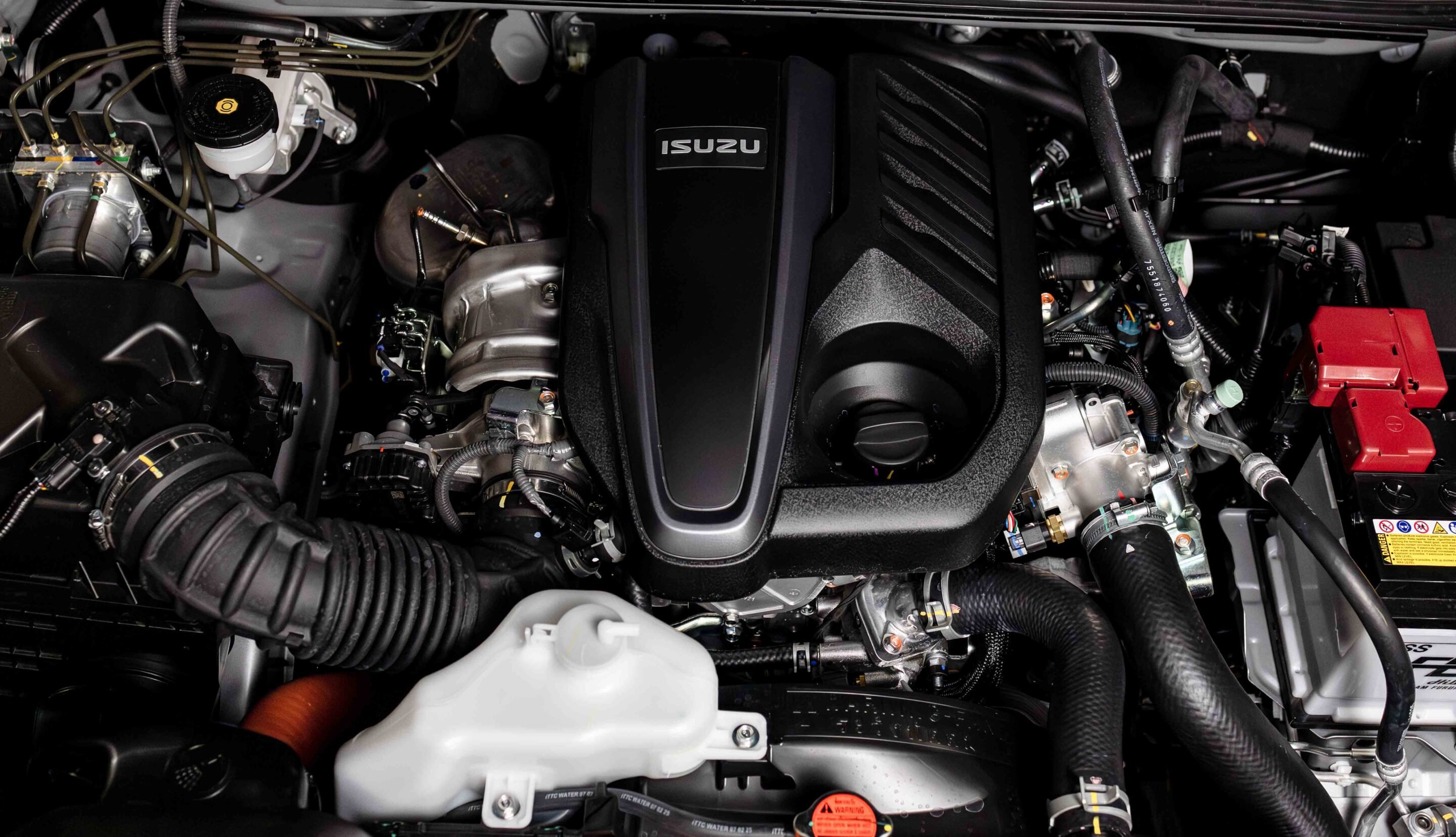
“In terms of the Euro 6 engines there (at Isuzu Trucks), it’s a different ADR category,” explained IUA Senior Product Manager, Aaron Carty, when asked about the Euro 6 4J engine. “So for us, we’re striking the balance between what the consumer wants and likes, versus compliance and regulation. So when the time comes that we have to be Euro 6, we’ll be Euro 6, but right now it’s more cost-effective to provide a vehicle that’s compliant to the current regulations.”
When asked if the 3.0-litre models will receive the eight-speed automatic, senior executives at IUA ruled it out, calling into question the engine’s future here. Even with the new stop-start system, IUA confirmed that the 3.0-litre engine emits 187g/km of CO2, and the MU-X is worse at 200g/km, meaning next year’s 180g/km threshold will likely hurt the 4J.
Confusion about IUA’s future models aside, they gave us the keys to a handful of 2.2-equipped D-MAX and MU-X variants and told us to drive from the Royal Pines Resort on the Gold Coast, out to Swan Gully 4WD Park for some testing – a proposition we were quite okay with.
How does it drive?
As an owner of a 3.0-litre D-MAX, I went into this test with low expectations, especially after rather disliking the 1.9-litre engine on the handful of occasions I drove it – from its strained power to the clattery racket it made.
But the 2.2-litre is a very different beast, quiet and refined, and the eight-speed behind it is a serious step-up from the six-speed that’s starting to feel a little bit dated and isn’t without its quirks – like the inconsistent converter lockup and gear selection.
This new eight-speed ’box is decisive in its gear choices, quick to change and feels like it has a tighter lockup when on and off the throttle. The six-speed works with the 4J, using the engine’s torque ride the ratios, but it would without a doubt have let the smaller engine down, as it did for the 1.9-litre.
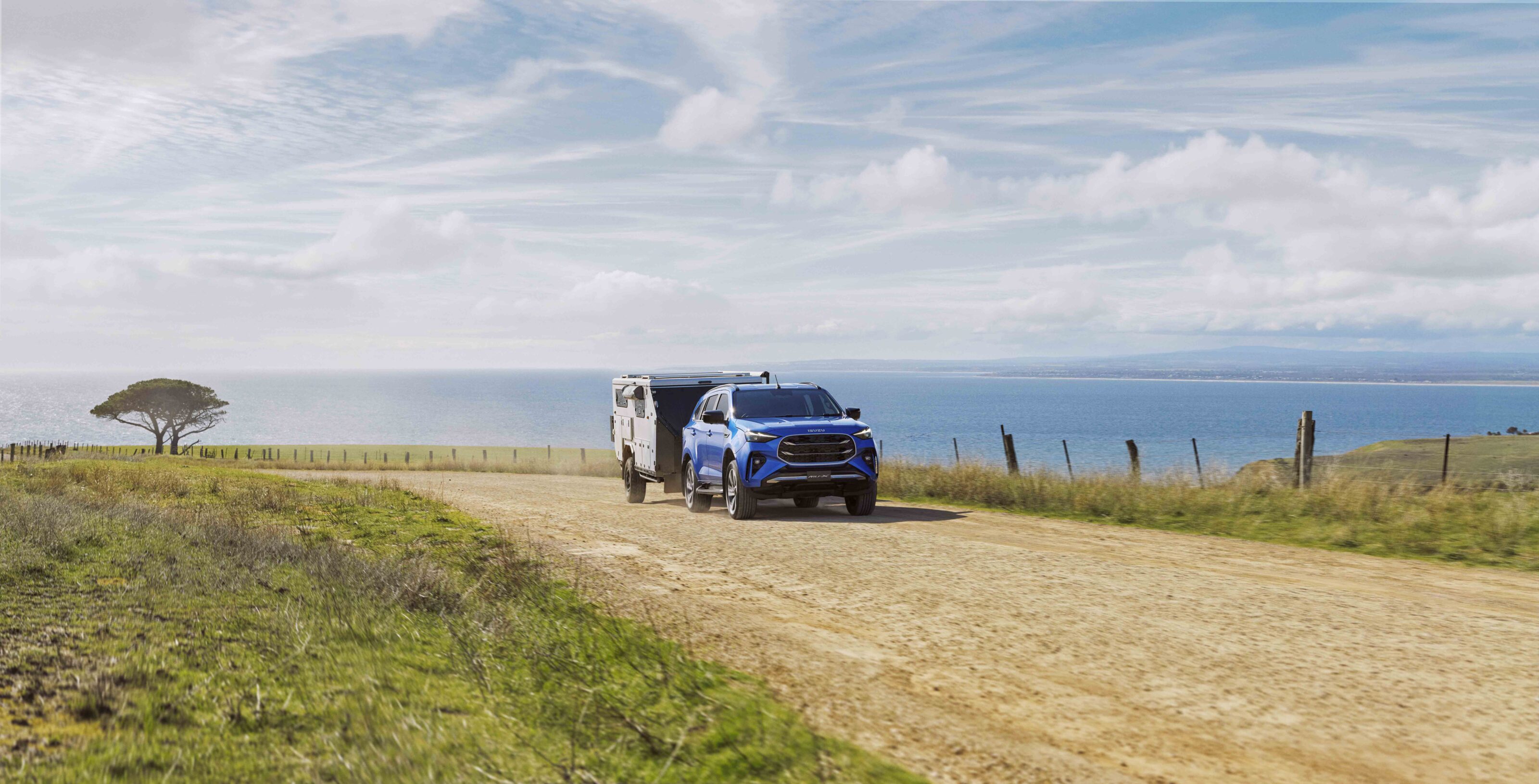
“I think the 1.9-litre engine might have highlighted some of the six-speed’s weaknesses, and vice versa, even though that gearbox works so well with the 3.0-litre,” Aaron told us, when discussing the move to an eight-speed transmission.
The new gearbox goes a long way in compensating for the 50 missing Newton metres, and during part-throttle, around-town use the lack of grunt is barely perceptible, even for someone who’s in a 3.0-litre almost everyday. Where the six-speed will hold a gear, relying on the 4J’s propensity to lug, the eight-speed drops a cog but to its credit does so quickly and without confusion. Owners who drive mostly around town are probably going to prefer the eight-speed, because it’s smoother, quicker and more efficient.
Another benefit of the new ’box is that it offers six low-range gears compared to four in the six-speed transmission, which could be felt when crawling up and down some of the rocky sections around Swan Gully. The six-speed has a tall first gear that can run away a bit downhill, but this transmission feels pretty damn good everywhere.
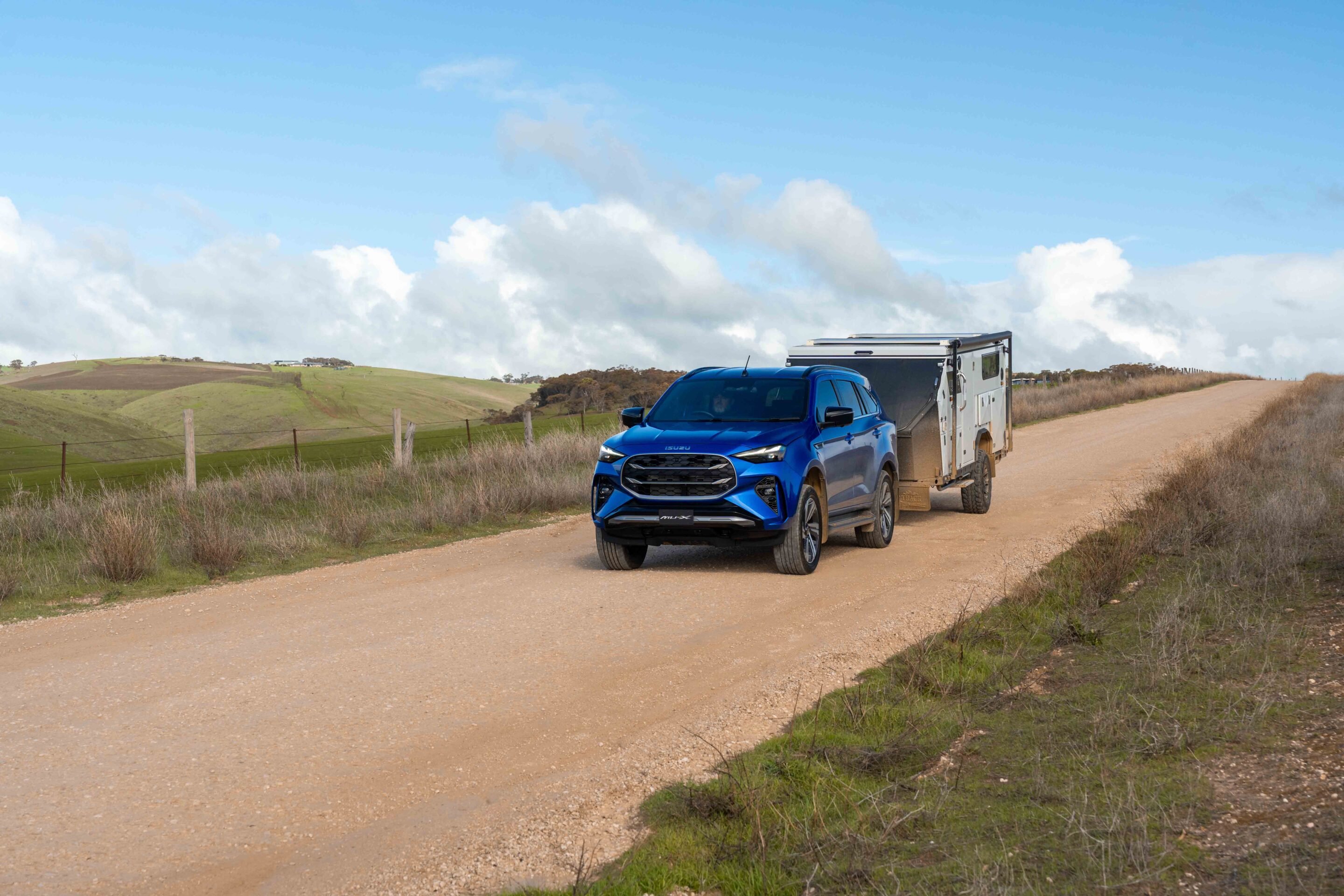
Manually hold gears, or tow, and the downrated power becomes noticeable, as I soon discovered. I was given the chance to tow a two-tonne Lifestyle Campers off-road camper behind a 2.2 D-MAX for the final stretch of on-road driving, as well as during some light off-road work at Swan Gully, and that’s when this engine started to feel a little bit underwhelming.
Up hills or when accelerating from a stop, it was a foot-flat affair to keep the little engine singing. Ideally, we’d like to put three or more tonnes behind it, to see if it can handle it, but if you’re pulling those kinds of weights you probably aren’t interested in a downsized engine.
Once back in an unladen MU-X, it was time to tackle the gnarlier trails. I really couldn’t feel much of a difference, compared to the 3.0-litre models, with the gearbox making good use of the engine’s power. Then there’s the excellent Rough Terrain Mode, which dials the braked traction control (or nerd lockers) to 11, making it almost boring to wheel one of these – it’s that good.
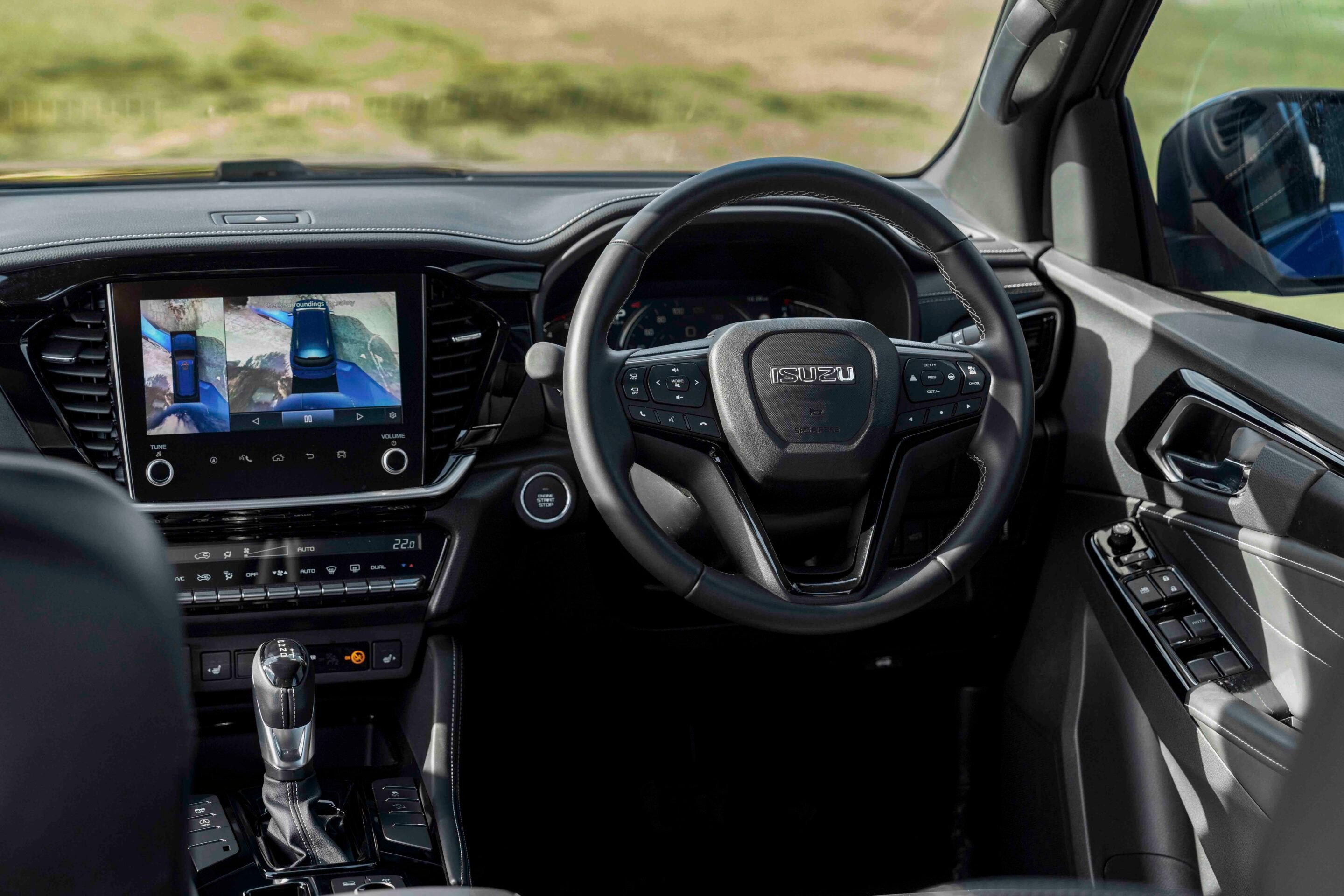
IUA claims the new engine sips 6.6L/100km in the D-MAX and 6.9L/100km in the MU-X, beating out even the 1.9-litre’s drinking habits by 0.3-0.9L/100km. While the gearbox probably contributes, it’s the use of an Idle Stop Start (ISS) system that really brings the consumption down. Now, I’m not a fan of stop-start, both because it’s hard on cold engines, batteries and starter motors, but also because it’s annoying in traffic. In summer it’s most annoying, because it shuts the A/C off.
Credit where it’s due, though, the Isuzu system is smart. It won’t shut down the engine if it’s cold (or hot), if there’s steering lock applied, if the air-con is turned right up, or if the battery temp is outside of its optimal range. As I discovered, the system also turns off when in low-range. Isuzu has fitted a larger battery to compensate for the extra starts, and you can always turn it off with the press of a button. Once I’d tried the system out, that’s exactly what I did.
As far as overall vehicle dynamics, the new models steer, stop and drive the same as their larger engined-siblings on- and off-road. It’s only when you plant it that the slight lack of power becomes evident. They also get all the same standard fare, like a part-time 4×4 system with locking rear diff, ADAS safety systems, modern infotainment with wireless phone mirroring, and from the outside they look identical. The new models also retain the five-star ANCAP rating.
Verdict
I could live with the new powertrain in a daily driver, with the occasional off-road trip thrown in. However, until Isuzu achieves power ratings on par with other downsized diesels like Ford’s 2.0-litre bi-turbo (157kW/500Nm) or Nissan’s 2.3-litre turbo-diesel (140kW/450Nm), this is an option best suited to city-dwellers.
We just hope the mighty 4J lives on into the future, perhaps utilising the Euro 6 smarts of the Isuzu Trucks equivalent, or a hybrid system to put it on par with Toyota and Ford. At this stage, though, it all feels a bit up in the air.
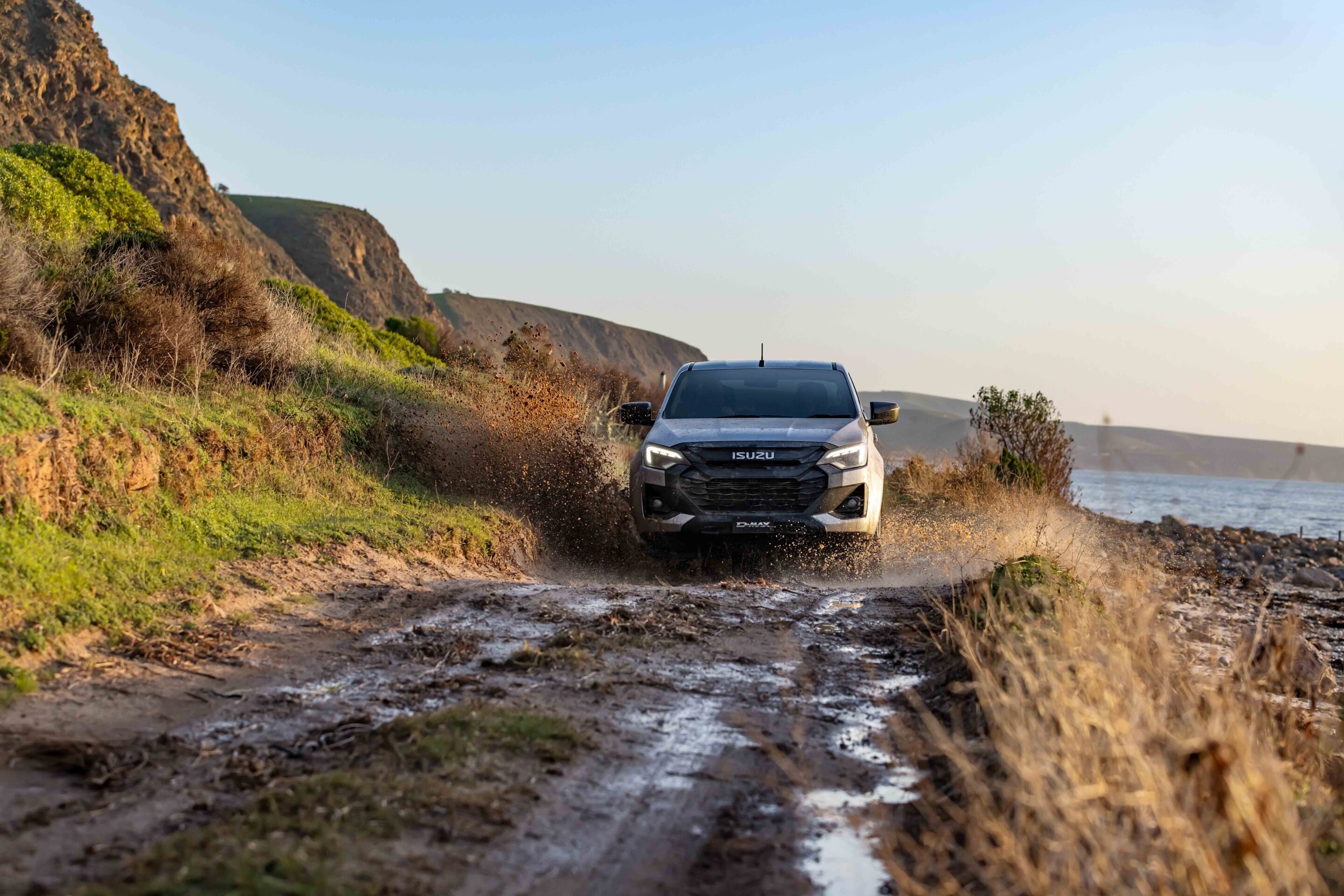
2026 Isuzu D-MAX pricing
| Model | Engine / Transmission | Price (AUD) |
|---|---|---|
| Single Cab Chassis SX | 3.0L AT | $46,200 |
| Space Cab Chassis SX | 3.0L AT | $49,700 |
| Crew Cab Chassis SX | 2.2L AT | $50,700 |
| Crew Cab Chassis SX | 3.0L AT | $52,700 |
| Crew Cab Chassis SX | 3.0L AT | $53,200 |
| Crew Cab Chassis LS-U | 3.0L AT | $63,500 |
| Crew Ute SX | 2.2L AT | $52,200 |
| Crew Ute SX | 3.0L AT | $54,200 |
| Crew Ute LSM X-RIDER | 2.2L AT | $59,500 |
| Crew Ute LSM X-RIDER | 3.0L AT | $61,500 |
| Crew Ute LS-U | 3.0L AT | $65,000 |
| Crew Ute LS-U+ | 3.0L AT | $68,000 |
| Crew Ute X-TERRAIN | 3.0L AT | $73,000 |
| Crew Ute BLADE | 3.0L AT | $80,900 |
2026 Isuzu MU-X pricing
| Model | Engine / Transmission | Price (AUD) |
|---|---|---|
| LS-M | 2.2L AT | $55,900 |
| LS-M | 3.0L AT | $57,900 |
| LS-U | 2.2L AT | $62,900 |
| LS-U | 3.0L AT | $64,900 |
| LS-T | 2.2L AT | $71,400 |
| LS-T | 3.0L AT | $73,400 |
| X-TERRAIN | 3.0L AT | $77,100 |
Ford Australia has introduced the Ford Pro Convertor (FPC) program, designed to simplify and streamline the process of getting certified vehicle conversions and customisations for commercial use.
The program focuses on industries that often need specialised modifications including utilities, construction, emergency services, mining and overlanding. It connects customers with a network of Ford-approved converters across the country.
To join the program, converters must pass a detailed assessment by Ford, covering both their capabilities and installation methods. Approval is segment-specific, meaning a converter may be certified for certain types of modifications but not others. Conversions completed under the program carry a warranty that matches Ford’s standard new-vehicle coverage.
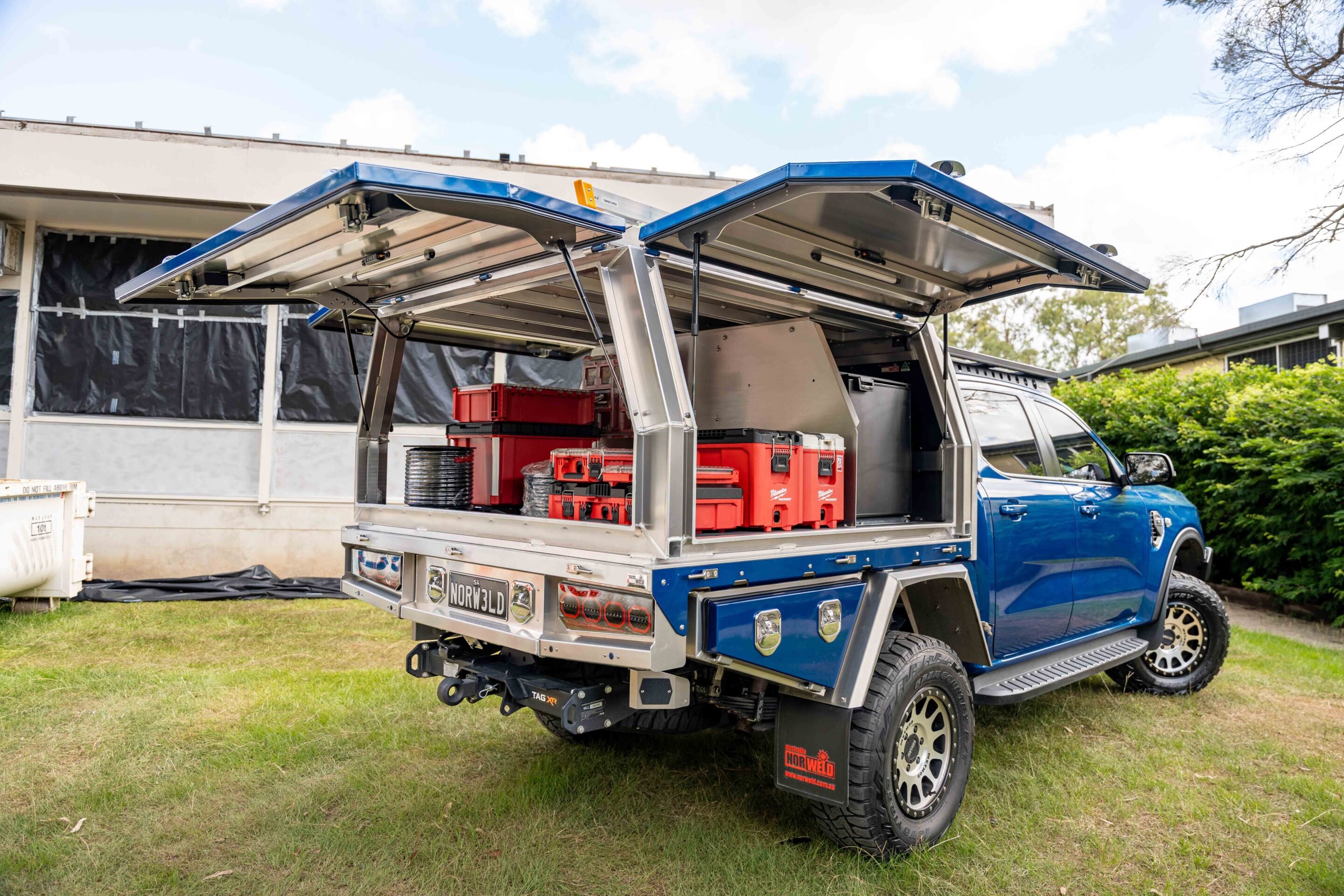
“We have meticulously selected and certified our Ford Pro Convertors, ensuring they meet Ford Pro Convertor standards and cater to the needs of a wide range of customers,” said Michael Elias, General Manager, Fleet, Ford Australia.
The Ford Pro Convertor program works alongside Ford’s existing Genuine Accessories and dealer-fit Licensed Accessories, providing more complex and tailored modifications that standard accessories cannot cover. Ford says the aim is to help businesses keep vehicles on the road, reduce downtime, and improve overall productivity.
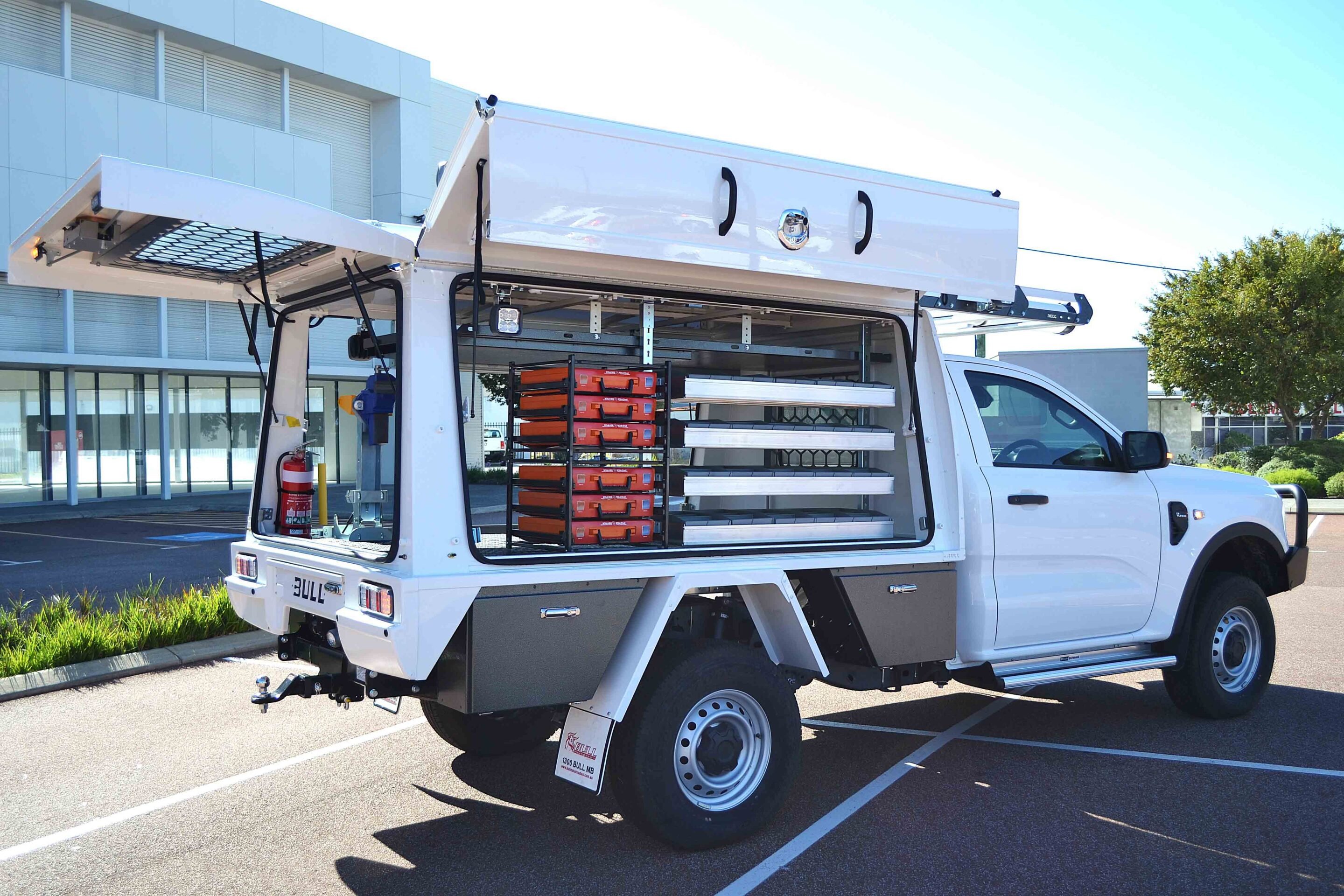
“Every business is different, and they all require their vehicles to be tailored to their unique needs, with the quality, professionalism, and peace of mind that allows them to get on with the job,” said Andrew Birkic, President and CEO, Ford Australia and New Zealand.
At introduction, approved converters include Bull Motor Bodies, Duratray, Hidrive, Mits Alloy, Norweld and XL Service Bodies. Ford plans to expand the program in the future, increasing the range of certified modifications available.
Further details on each converter’s certified segments and modifications are available on the Ford Pro Convertor Program webpage.
Toyota Australia (TMCA) has previewed the LandCruiser 300 Performance Hybrid, arriving in early 2026. The petrol-hybrid returns petrol to the LC300 range, limited to GR Sport and Sahara ZX two-row, five-seat models, with a price premium expected.
Adapted from the Tundra’s TNGA-F chassis, the hybrid pairs a 3.5-litre twin-turbo V6 (326kW/790Nm) with an electric motor and 10-speed auto, driving through the LC300’s full-time dual-range transfer case. Off-road features including locking diffs, KDSS, MTS and Crawl Control remain unchanged, with a slightly raised cargo floor for the battery.
Toyota’s Performance Hybrid manages petrol and electric power via a clutch, with petrol active above 30 km/h and electric-only operation below. Fuel-consumption figures are yet to be released.
Pre-production drive
The GR Sport LC300 shown here was a pre-production version of the Performance Hybrid and, at the time, the only one in the country. Even so, Toyota was willing to let us take it for a drive on its short but comprehensive vehicle evaluation and training track at Altona.
With its tuning focused more on performance than outright efficiency, the system delivers strong acceleration, responsive power and ample torque for towing. To demonstrate this, we used a short straight section of road for a 0-100km/h blast in the 300.
Flooring the accelerator from a standstill delivered a hefty shove in the back – something you won’t experience in any other production 300 Series. The acceleration is forceful and rapid, with the needle sweeping past 100km/h in no time before we had to brake hard for a 90-degree corner. Toyota isn’t exaggerating when it calls this a Performance Hybrid, though it has yet to reveal any official 0-100km/h times.
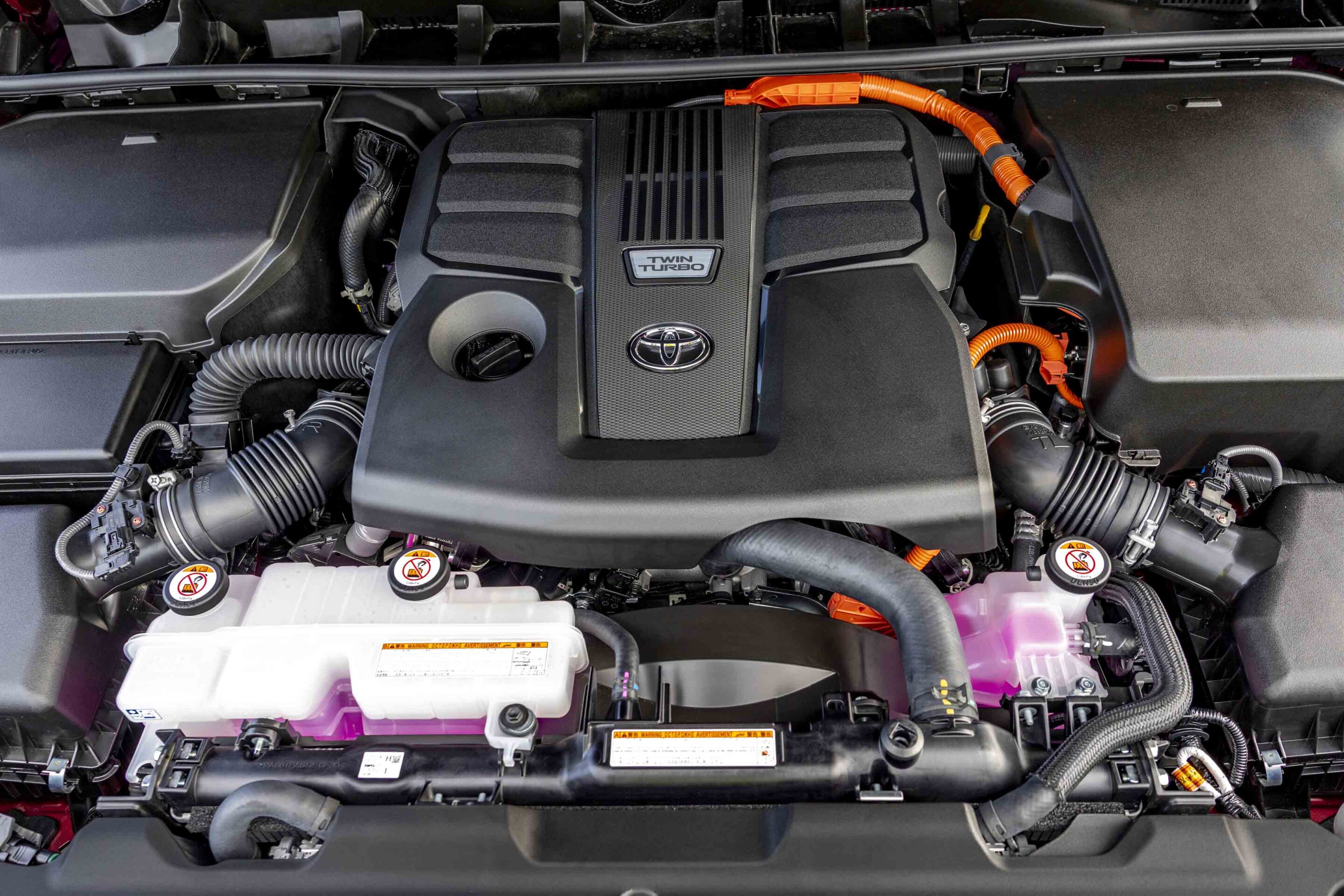
Off-road loop
The test track also features an off-road playground with offset moguls, humps, climbs and a water crossing, and since this was a GR Sport, it would have been remiss of us not to have a go.
The steep climb is cut with offset ruts designed to test a vehicle’s traction and highlight the suspension and electronic aids at work. We tackled it in low range with only the centre diff locked, leaving the GR Sport’s front and rear lockers disengaged. The hybrid retains all of the LC300’s rear-axle articulation to keep the tyres on the ground, while the sharp ETC system quickly quelled any slip and drove the Cruiser up and over.
It was a similar story over the offset moguls and a harsh bed of rocks, with the hybrid performing like any other LC300 – only without the clatter of a diesel engine.
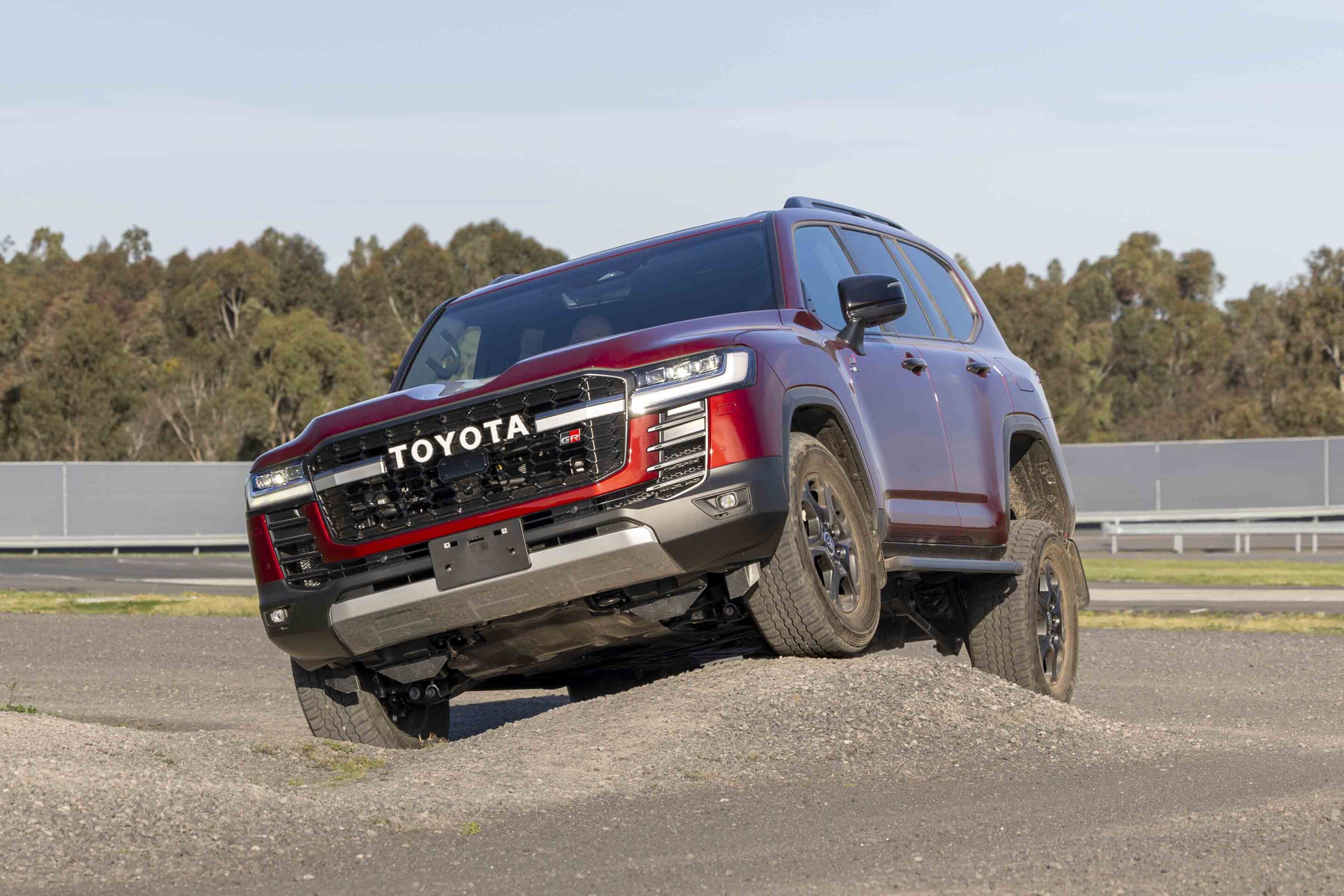
For giggles, we tackled the same obstacles using Crawl Control, and the system handled them just as easily without any throttle input from the driver. We then ran up the steep climb in reverse, again with Crawl Control engaged, proving this clever technology is just as effective in either direction.
Naysayers like to claim that EV-equipped vehicles can’t cross water, so we drove the LandCruiser through a pond with a water depth of 600mm. Needless to say, it went through repeatedly without issue. Toyota is adamant that the hybrid powertrain does not diminish the LandCruiser’s capability in any way.
While this is the first Australian application of Toyota’s Performance Hybrid, the company is quick to remind us it has long been a hybrid pioneer, with five generations of technology since the first Prius launched 28 years ago. In that time, TMCA has sold more than 500,000 hybrid vehicles locally, and today nine models in its line-up are exclusively hybrid-powered.
Hybrids now make up almost half of Toyota’s total sales in Australia.
The Nissan Patrol has a long and proud history, with production of the first generation of this legendary off-roader kicking off in 1951 – the same year Toyota began producing the LandCruiser.
Called the 4W Series, these early Nissan off-roaders (4W60) looked very similar to a Willys Jeep and were only sold in Japan. This model was updated in 1955 with the introduction of the 4W61, but it wasn’t until the release of the 4W65/4W66 variants in 1958 that the vehicle first wore Patrol badges on its bonnet.
A year later, the 3956cc Nissan P engine was introduced. This donk would eventually power the 4W’s successor, the 60 Series, which would be the first Patrol officially sold in Australia.
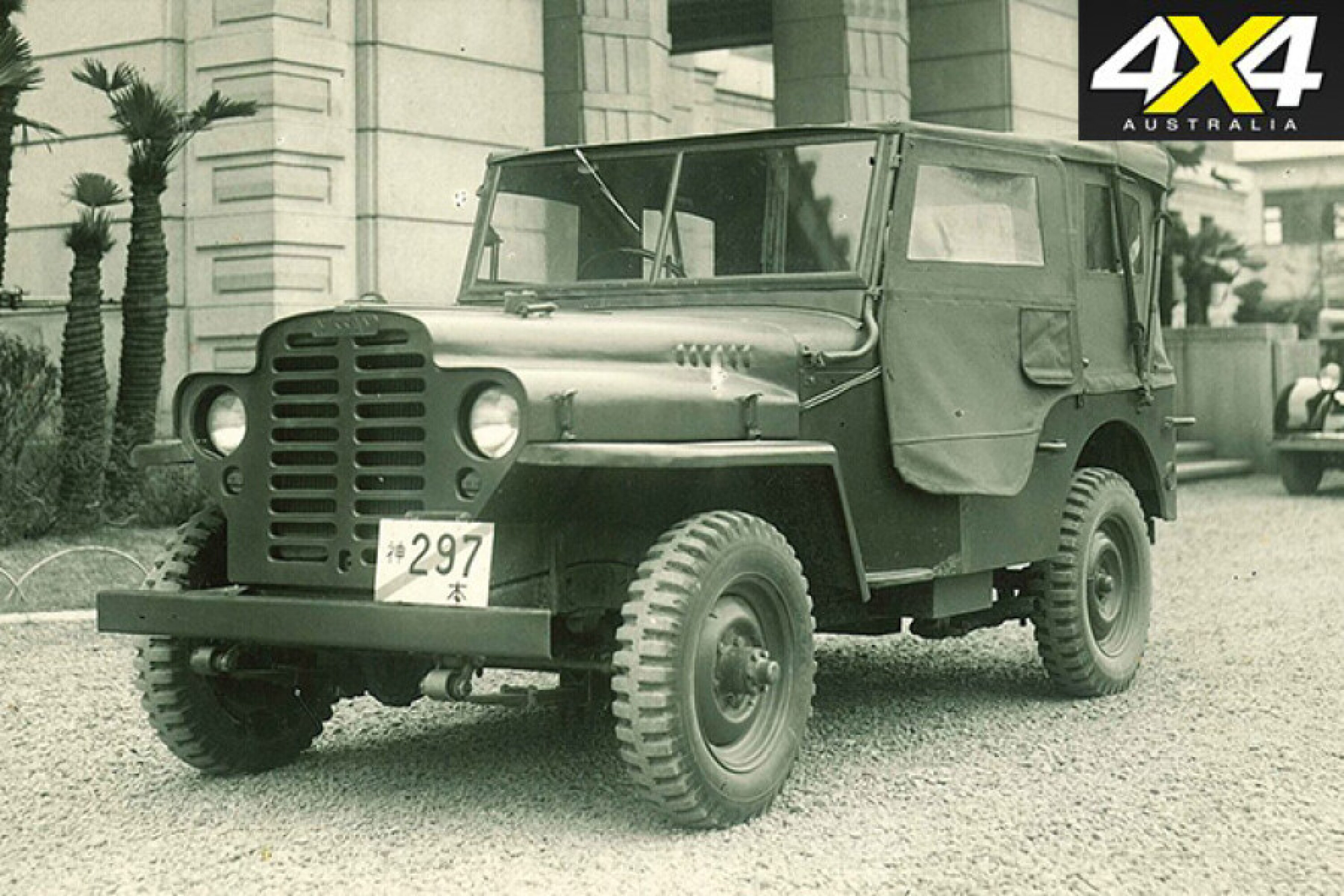
JUMP AHEAD
60 Series
Nissan began exporting the Patrol in the early 1960s. The first model to make it down under was the 60 Series, which was powered by the aforementioned 4.0-litre six-cylinder P engine.
With a separate chassis and relatively basic leaf-spring suspension, the 60 Series was sold in Australia in a number of variants, including the short-wheelbase soft-top 60, the K60 hardtop, and the long-wheelbase G60 in wagon and pick-up body styles. Early examples of the 60 had a three-speed manual transmission and a two-speed transfer case; a four-speed manual was eventually introduced.
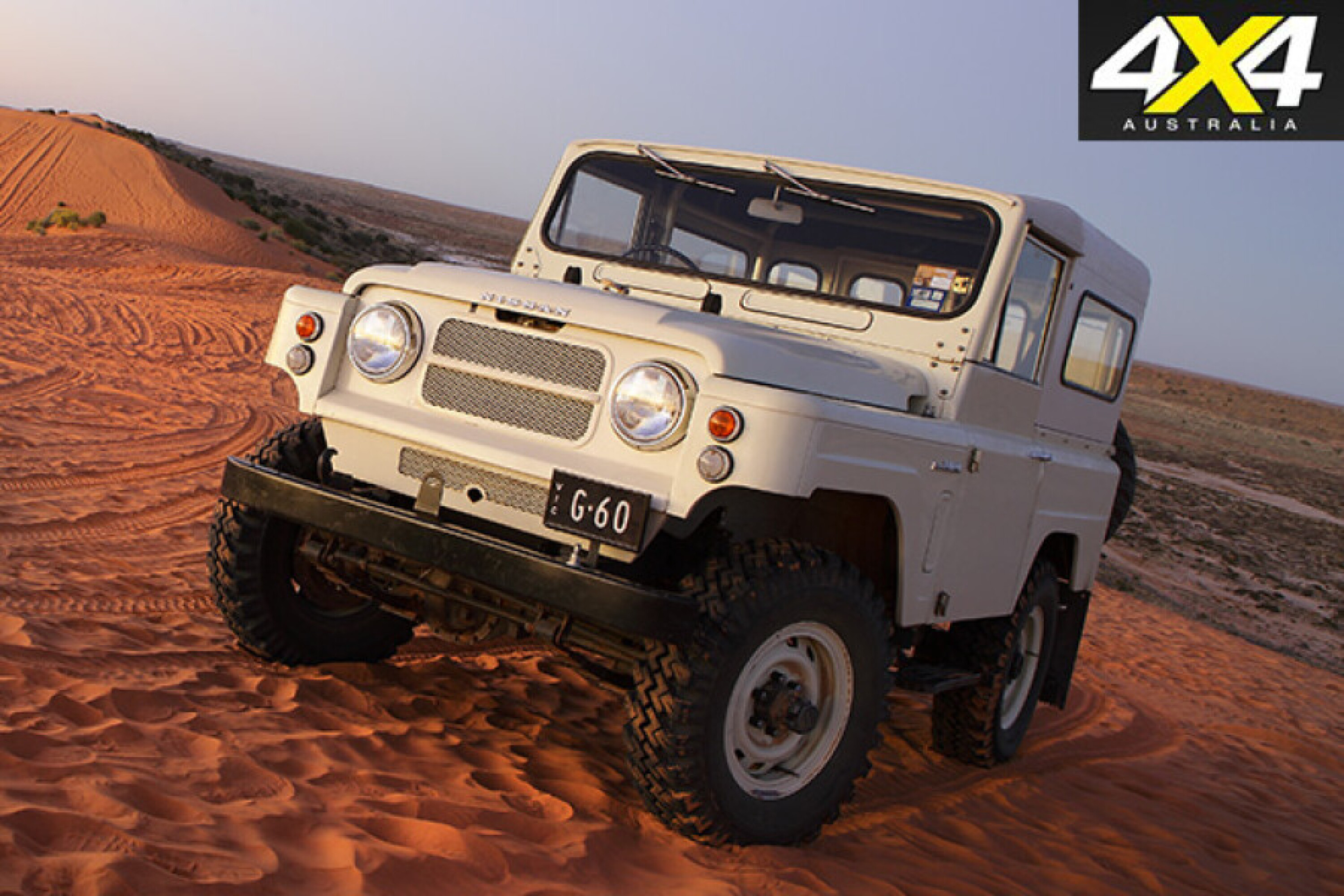
In 2012, Nissan celebrated the 50th anniversary of what it claimed to be the first vehicular crossing of the Simpson Desert. The vehicle used in that 1962 crossing was a G60 Patrol, and it was piloted by famous geologist and founder of South Australia’s Arkaroola Wilderness Sanctuary, Reg Sprigg. Sprigg was accompanied on the journey by his wife Griselda and their children Doug and Marge.
The 60 Series Patrol would see active duty for an impressive 20 years, and over that time it changed little, other than minor updates to some body components and the engine. By the time it was replaced by the MQ Patrol in September 1980, the 60 had certainly reached its use-by date.
MQ Patrol
When the MQ Patrol (160 Series) was introduced to replace the 60 Series in 1980, the worldwide four-wheel drive market was rapidly evolving.
While still based on a relatively basic platform (separate chassis and live-axle, leaf-spring suspension), the MQ Patrol had a more modern body style, was available in bright colours with ‘loud’ graphics, offered a choice of petrol and diesel six-cylinder engines and included short-wheelbase and long-wheelbase models in the line-up, along with a variety of body styles (SWB hardtop, pick-up, cab-chassis and wagon).
Driveline variants included a 3.3-litre diesel engine and 2.8- and 4.0-litre petrol engines. Initially a four-speed manual gearbox was the only option, but by the end of 1981 buyers of the deluxe seven-seat wagon could opt for a three-speed automatic transmission. A new limited-slip rear differential was also introduced.
A facelift of the MQ Patrol was launched in 1983, which featured upgraded front suspension and stylish-for-the-time rectangular headlights.
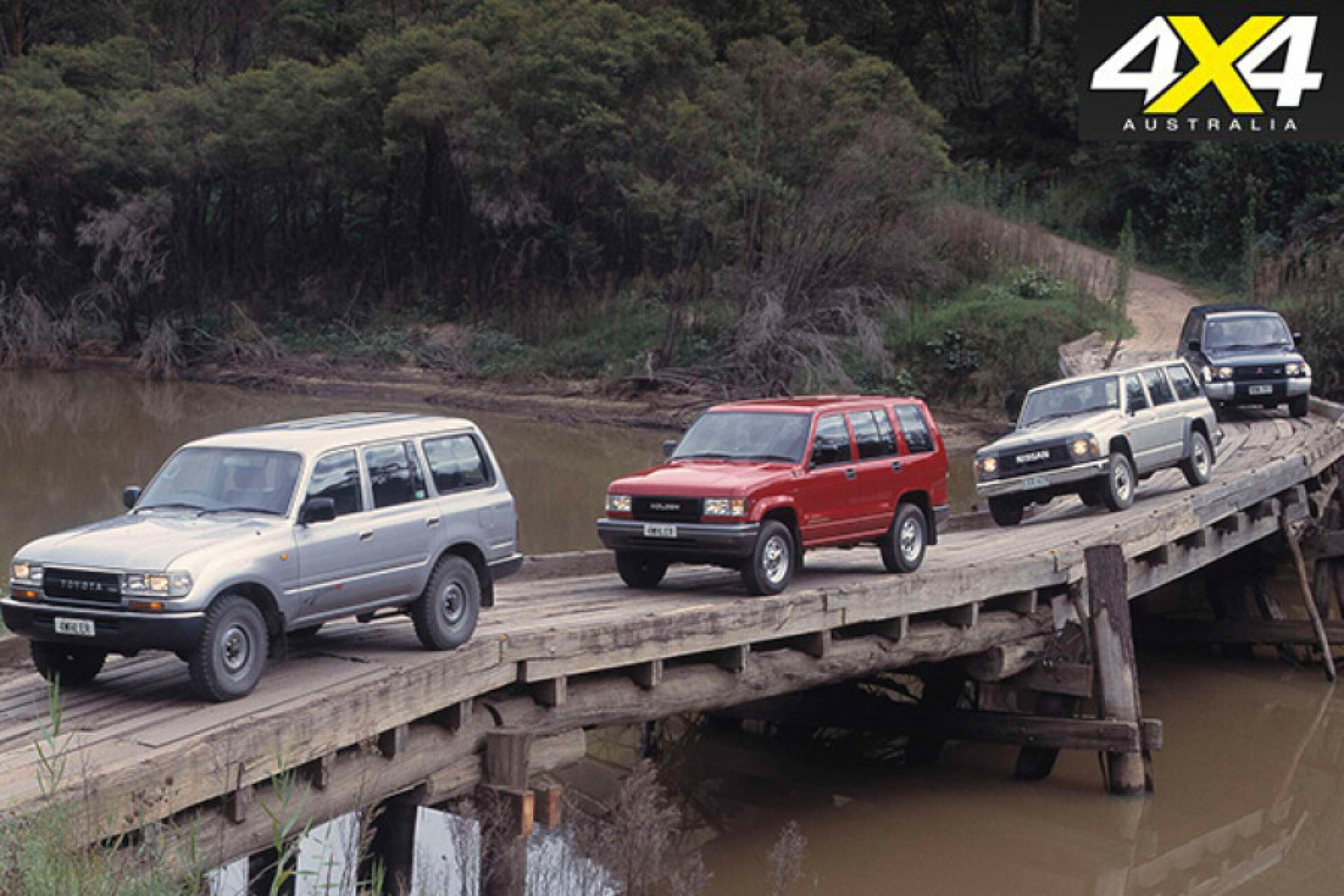
Importantly, the MQ also scored a five-speed manual transmission, while the 24-volt electrical system employed on the SD33 diesel engine version was flicked in favour of a more traditional (and therefore more compatible with most accessories) 12-volt electrical system.
A turbocharged version of the SD33 was introduced, making a claimed 81kW and 255Nm, and owners of this model didn’t go unnoticed thanks to the massive ‘TURBO’ stickers on the rear panels of the Patrol.
Nissan had a strong Patrol line-up in the MQ, with more than 20 variants on offer towards the end of its lifespan
With its choice of bright colours, modern styling, optional fancy white Sunraysia-style rims and relatively high equipment levels (AM/FM radio cassette, digital clock, optional air-conditioning, comprehensive instrument panel), higher-spec versions of the Patrol became popular with recreational four-wheel drivers, in both short-wheelbase hardtop and long-wheelbase wagon variants. However, base-spec models and pick-up/cab-chassis models still appealed to rural/business buyers.
There were further updates to the MQ Patrol in 1986, with a more powerful 4.0-litre petrol six and the five-speed gearbox becoming standard across the range, along with standard power steering.
Nissan had a strong Patrol line-up in the MQ, with more than 20 variants on offer towards the end of its lifespan, and with relatively keen pricing, it could take the fight to Toyota’s 40 and 60 Series LandCruisers. However, the big news for Patrol was still a year away.
GQ Patrol
Until the launch of the GQ Patrol (Y60) in late 1987, Nissan always played second fiddle to Toyota, which had its hugely popular LandCruiser spearheading its four-wheel drive line-up.
But Nissan got the hop on Toyota when the all-coil-spring GQ Patrol landed locally, and it sold like hotcakes compared to the now-outdated leaf-spring 60 Series LandCruiser. Nissan held on to this technical (and therefore sales) advantage until 1990, when Toyota finally rushed the 80 Series to market.
There were some carry-over body parts from the MQ, but the new GQ Patrol was light years ahead of its predecessor (and competition) in terms of styling, ride quality and refinement.
Its long-travel, coil-spring suspension offered a blend of on-road comfort and off-road performance that couldn’t be matched – at least without taking out a second mortgage and buying a Range Rover.
There were two engine options in the GQ Patrol line-up: the 4.2-litre OHV TB42 petrol six (125kW/325Nm), and the 4.2-litre OHV TD42 diesel six (85kW/264Nm)
Up front, the GQ Patrol sported a three-link, live-axle, coil-spring arrangement, while the rear was a five-link design (the cab-chassis variant was initially offered with only a leaf-spring rear-end). Sway bars were fitted at both ends and some models featured rear sway bar disconnects for increased wheel travel in off-road situations.
Initially there were two engine options in the GQ Patrol line-up: the 4.2-litre OHV TB42 petrol six (125kW/325Nm), and the 4.2-litre OHV TD42 diesel six (85kW/264Nm). Both engines were mated to a heavy-duty, five-speed manual or a four-speed auto transmission, and power was directed through a two-speed transfer case and part-time 4WD system.
A limited-slip rear diff was standard, or a rear diff lock could be selected as an optional extra on some models. All wagons featured four-wheel disc brakes, while the cab-chassis retained drums at the rear.
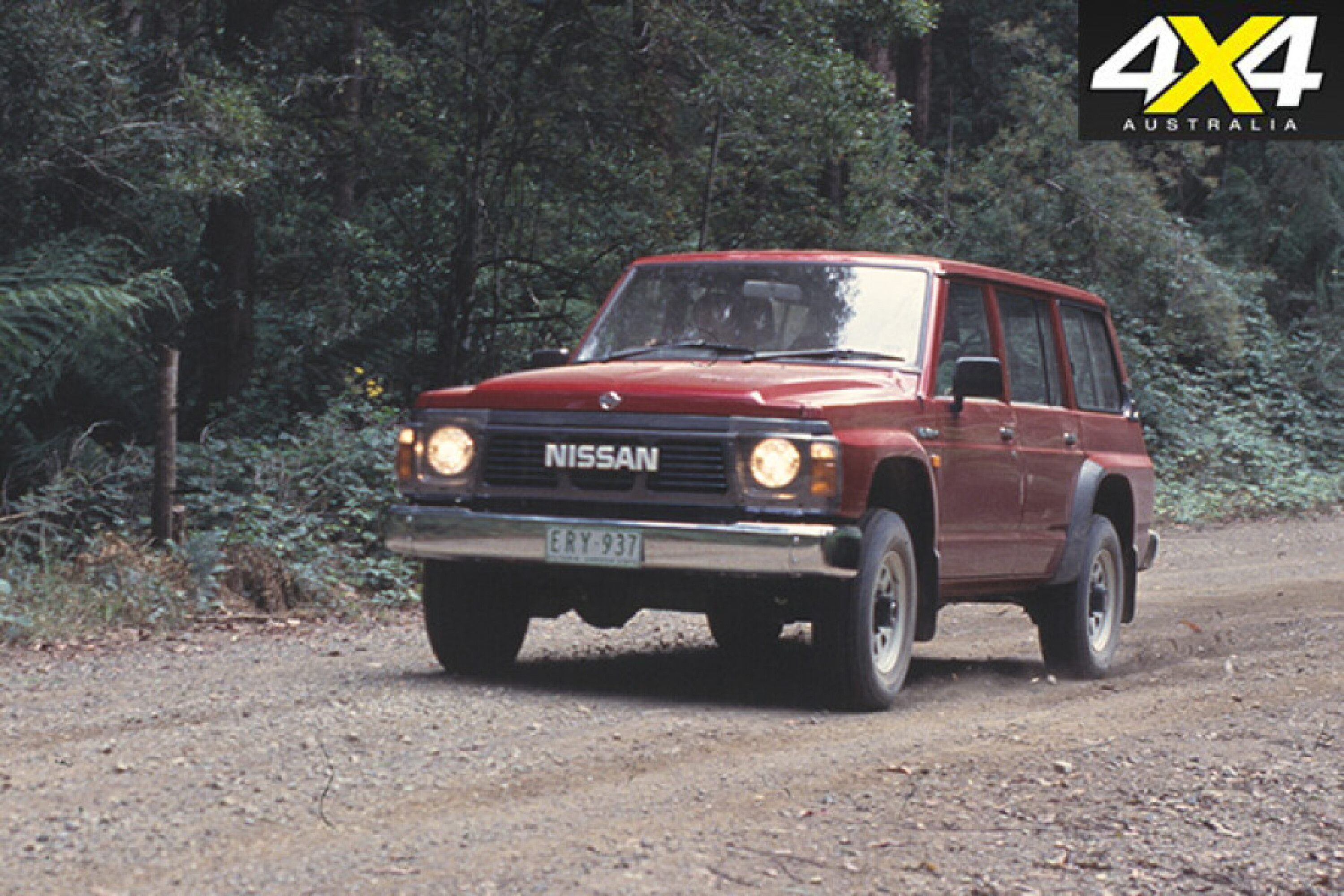
There were a variety of trim levels on offer, starting with the base-spec DX, which had vinyl trim, manually operated windows and mirrors, manual free-wheeling hubs and optional air conditioning. The ST added cloth trim, power windows and mirrors, central locking, standard air conditioning and auto hubs (with manual override).
A high-roof Ti model was added in 1989, which scored velour trim, carpet, rear air conditioning, upgraded sound system and alloy wheels. The high-roof (called the Safari Roof) was flicked in 1991, although the Ti model was retained in the line-up, albeit with standard roof height.
Nissan added a third engine to the Patrol wagon line-up in 1990: the 3.0-litre RB30 petrol six (100kW/224Nm). This was the same engine used in the Nissan Skyline and Holden VL Commodore and, while not ideally suited for use in a big, heavy 4WD like the Patrol, it proved popular thanks to keen pricing. This engine was only offered with a five-speed manual transmission in seven-seat ST spec, which was later renamed ST3.
In 1994, a coil cab version of the GQ Patrol was added to the Nissan line-up
The Patrol was updated in 1992, when the GQ Series II was launched. Among other refinements, the 4.2-litre petrol engine gained the benefit of electronic fuel injection (EFI), which improved refinement but did little for the engine’s thirsty nature. Other updates included the addition of side-intrusion beams in the doors, tweaks to suspension and transmission, bigger brakes and changes to the standard equipment list.
From 1989 to 1994, Ford Australia sold a rebadged version of the GQ Patrol called the Ford Maverick, in both long- and short-wheelbase models. Ford offered both the TB42 petrol-six (manual or auto) and the TD42 diesel-six (manual only).
In 1994, a coil cab version of the GQ Patrol was added to the Nissan line-up, which was sold alongside the pre-existing cab-chassis and pick-up models that sported the leaf-spring rear-end.
The coil cab offered vastly superior ride to the leaf-spring cab-chassis variants, especially when unladen or with only a light load on board. And surprisingly, the five-link, coil-spring suspension arrangement added less than $1500 to the price of the cab-chassis Patrol, proving popular with recreational four-wheel drivers who didn’t need a wagon.
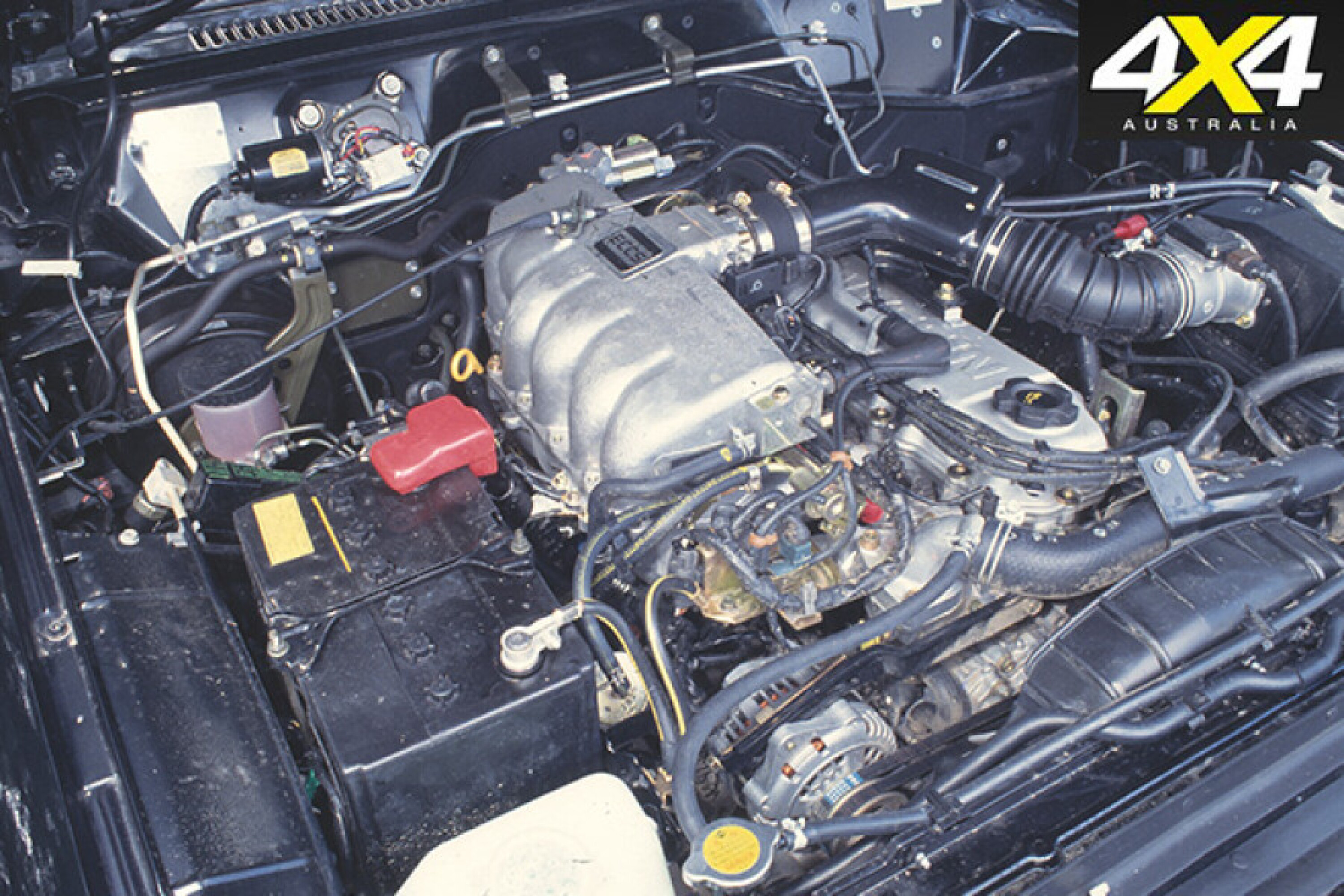
However, the leaf-spring version was still a favourite among rural/business buyers; old-school thinking dictated that only leaf springs were suitable for hauling heavy loads.
The GQ Patrol underwent another update in 1995, at which point the RD28T 2.8-litre turbo-diesel six-cylinder engine was added to the line-up, in both DX and ST trim levels. The boosted engine produced the same peak power as the TD42 (85kW), albeit at slightly higher revs (4400rpm as opposed to 4000rpm), but couldn’t match the bigger, naturally aspirated engine for torque output, making just 235Nm at 2400rpm as opposed to 264Nm at 2000rpm.
Nevertheless, on-road performance was similar thanks to significantly shorter gearing; the trade-off being less relaxed highway touring. Only available with a five-speed manual transmission, the RD28T’s gearbox was a lighter unit than the one mated to the TD42, and it also missed out on the latter’s excellent transmission-mounted drum parking brake.
Despite its shortcomings, the RD28T version of the Patrol proved popular thanks to keen pricing
Despite its shortcomings, the RD28T version of the Patrol proved popular thanks to keen pricing – it offered a saving at the time of around $4K compared to a similarly equipped TD42 Patrol.
Nevertheless, the TD42 Patrol was the favourite among outback tourers who loved this engine’s relative simplicity, decent performance and legendary reliability. For those who wanted extra performance, a number of Nissan dealers offered the superbly engineered Safari turbo and intercooler kits as a dealer-fit option.
Despite the big choice of engine/transmission/spec-level options offered by Nissan, towards the end of the GQ’s lifespan the Patrol was no longer a match for Toyota’s 80 Series LandCruiser, which was now available with a 1FZ-FE 4.5-litre petrol engine, a 1HZ 4.2-litre naturally aspirated diesel engine, and a 1HD-T direct-injection 4.2-litre turbo-diesel engine.
Nissan fans had high hopes when a rumoured replacement for the GQ Patrol was set to land in Australia in 1997 but, initially at least, many would be disappointed.
GU Patrol
When the new GU Patrol (Y61) arrived in Australia in late-1997, it boasted all-new sleek bodywork that was a far cry from the dated and boxy-looking GQ, which could trace its lineage to the MQ that first saw the light of day back in 1980.
But under the GU’s new skin lurked a familiar platform – the ‘new’ GU was essentially a GQ Patrol with new clothes.
Despite the chassis, suspension and driveline similarities, the GU Patrol was a big improvement over its predecessor, offering a wider body that delivered much more interior space, greater refinement, improved NVH (noise, vibration and harshness) levels, better aerodynamics and a vastly more comfortable interior.
On the downside, the GU was significantly heavier than the GQ, and when it first landed the GU Patrol was only available with Nissan’s new TB45E 4.5-litre OHV petrol six, mated to either a five-speed manual gearbox or four-speed auto. And while the petrol six-pack offered decent performance on the road and a good spread of torque (145kW at 4000rpm; 350Nm at 4300rpm), it was thirsty and not at all aligned with the market that Nissan had previously cultivated with Patrol, which in the latter years of the GQ model was heavily skewed towards diesel sales.
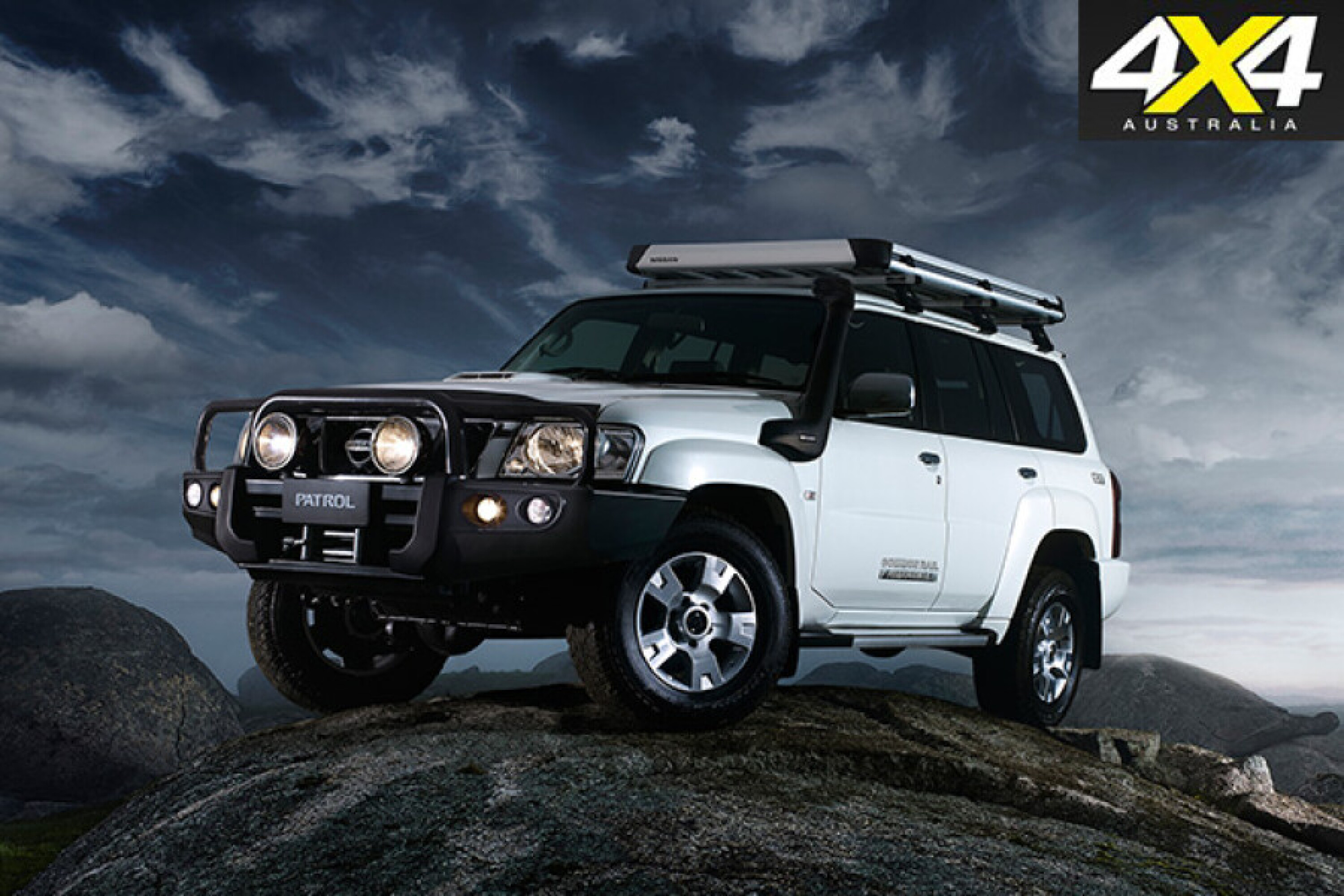
Further limiting the chance of early sales success, the GU Patrol was initially launched in just ST and Ti model variants; there was no longer the wildly popular (and affordable) RX version, and the base-spec DX model was not due to appear until around mid-1998.
The first of the GU Patrol oil burners was the RD28ETI, which was an electronically injected and intercooled version of the GQ Patrol’s 2.8-litre turbo-diesel six. Claimed power was up to 95kW at 4000rpm and torque up to 252Nm at 2000rpm, but in the GU Patrol the engine had to deal with an additional 230kg of weight compared to the GQ. Unfortunately, the new turbo-diesel was not the most refined engine around; performance below 2000rpm was wanting, and above that there was a sudden surge as the turbocharger did its thing.
Adding to the problem was a light and overly sensitive throttle that made smooth progress, particularly in bumpy off-road conditions, somewhat difficult to achieve. The RD28ETI was initially offered in DX ($39,950) and ST ($43,990) trim levels, with a five-speed manual transmission the only gearbox choice.
When the TD42 4.2-litre naturally aspirated diesel version of the GU Patrol DX was finally launched in mid-1998, Nissan quoted slightly more output than the engine developed in its GQ application (up from 85kW to 91kW at 4000rpm and from 264Nm to 272Nm at 2000rpm). However, with a heavier body to lug around, performance was somewhat blunted.
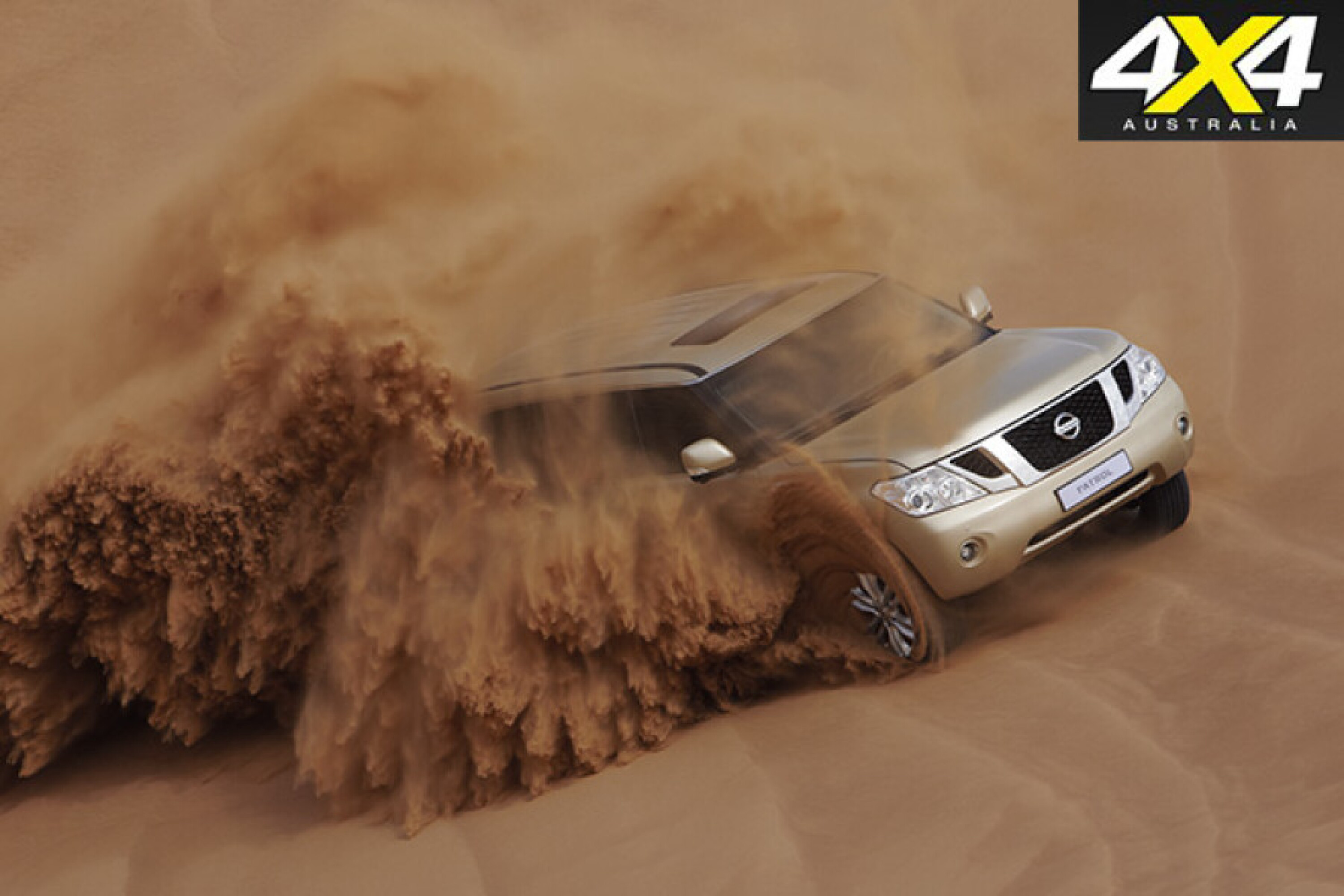
This diesel was also offered in cab-chassis and coil cab variants of the GU, and in early 1999 these utility models were also the first to receive the new TD42T, a turbocharged version of the TD42. The low-boost turbo boosted output to a modest 114kW and 330Nm and, importantly, it didn’t affect the big diesel’s flexible low-rpm grunt.
By mid-1999, the TD42T was made available in Patrol ST wagon specification, making it the most powerful diesel engine in its class (Toyota only offered the 1HZ in the 100 Series Cruiser at this stage and was yet to re-introduce an electronically injected version of the 1HD-FT).
In 2000, Nissan finally flicked the old RD28ETI 2.8-litre turbo-diesel six-pack in favour of an all-new four-cylinder turbo-diesel engine called the ZD30. This was the first time a Patrol had been powered by an engine that wasn’t a straight-six. With a claimed 116kW and 354Nm, the ZD30 promised a modern alternative to the old-school TD42 and TD42T powerplants, as well as an auto transmission.
However, the new engine had a few gremlins and it gained a reputation for poor reliability. Problems included fuel pump issues and piston failures, and Nissan eventually increased the oil capacity of the engine and lowered the oil viscosity rating in an attempt to resolve the faults.
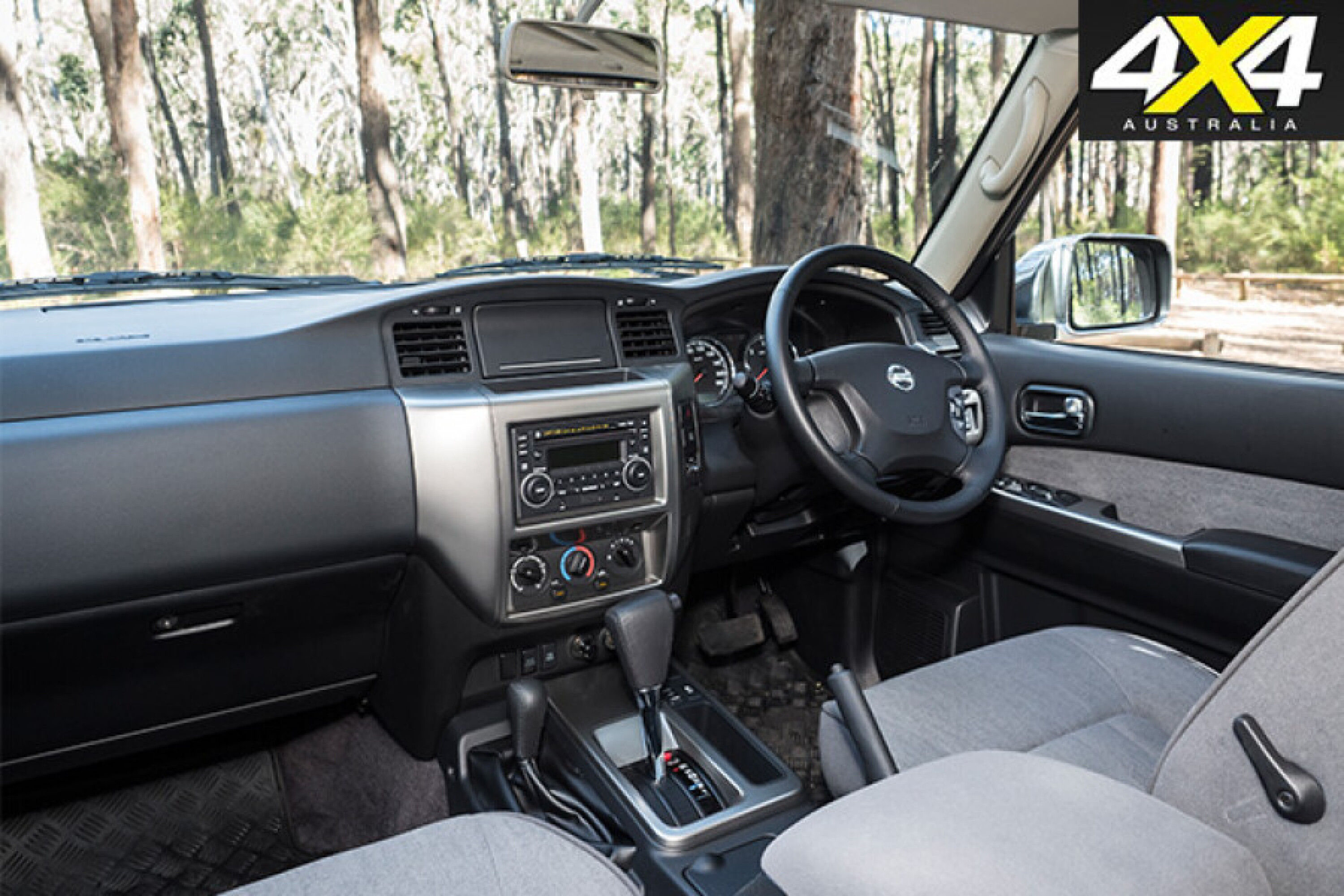
In 2001, Nissan increased the capacity of the GU’s petrol engine to a whopping 4.8 litres. It was thirsty, but it developed an impressive 185kW and chunky 420Nm, giving it class-leading performance.
The TD42T was given an intercooler in 2003 and renamed TD42Ti, and while power output remained unchanged at 114kW, torque was up slightly to 360Nm. Back-to-back testing back in 2003 showed that the more modern ZD30 had a slight performance edge over the TD42Ti, but the latter felt more refined.
The GU Patrol received its most significant visual makeover towards the end of 2004. Its legendary reliability and simplicity (the only electronic component on the TD42Ti injection pump was a throttle-position sensor that interacted with the EGR valve) made it more suited to remote outback travel. Having said that, the TD42Ti could get quite hot when driven in soft sand, but fitting a bigger aftermarket radiator was an easy fix.
The GU Patrol received its most significant visual makeover towards the end of 2004, scoring revised bodywork and a new interior. The ST and Ti models also received larger-diameter 17-inch wheels, and Nissan put some effort into NVH improvements.
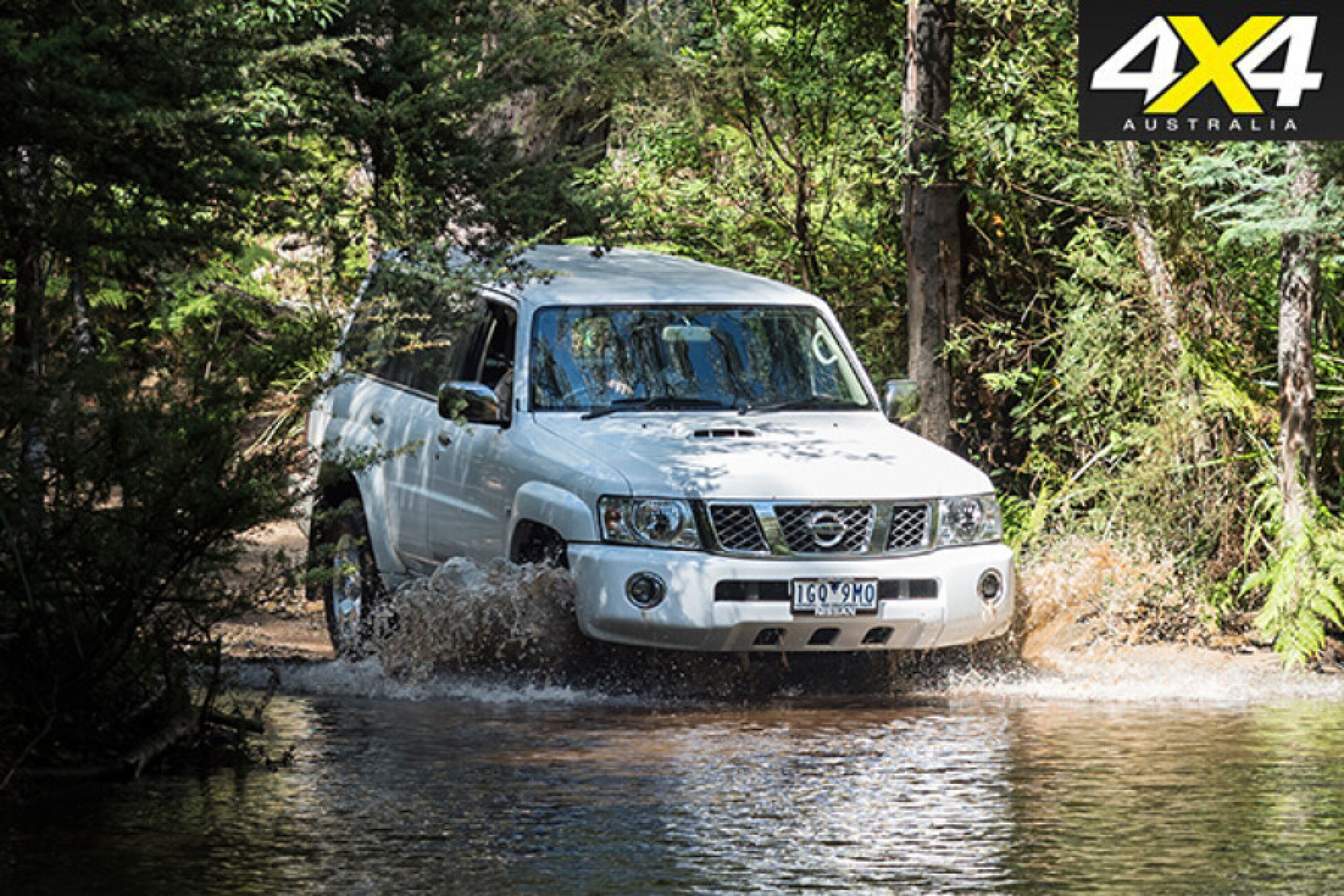
The 3.0-litre ZD30 turbo-diesel also came in for some upgrades, with improvements to the injector pump design, revised injector nozzles, reduced engine friction, an ECU tweak and larger exhaust diameter. Power was up slightly to 118kW at 3600rpm and torque (in manual variants) increased to 380Nm at 2000rpm (autos remained at 354Nm).
With the demise of the TD42 and TD42T engines in 2006, the ZD30 became the only diesel option for GU Patrol buyers, with the most recent version having a common-rail injection system.
Y62 Patrol
The Y62 Nissan Patrol was introduced to the Australian market in 2013, marking a significant evolution in the Patrol lineage.
This generation moved away from the GU series’ rugged, live-axle setup, adopting a petrol-only independent front suspension that offered a far more refined on-road experience. This change also marked the end of the GU Patrol’s 4.8-litre inline-six petrol engine, with the Y62 focusing on V8 power for a blend of performance, comfort, and towing capability.
From its launch, the Y62 was positioned as a premium large SUV, featuring a host of luxury and technology upgrades, but it retained full-time 4WD and a ladder-frame chassis to maintain its off-road credentials. Its independent suspension provided a smoother, more controlled ride, especially on paved roads, while still handling Australia’s varied terrain with competence.
In 2020, Nissan upgraded the Y62’s powertrain with a 5.6-litre naturally aspirated V8 producing 298 kW and 560 Nm. This engine solidified the Patrol’s place as a high-performance, large SUV capable of heavy towing and serious off-road work, while retaining the refined characteristics introduced in 2013.
Y63 Patrol
The next-generation Nissan Patrol, the Y63, is expected to arrive in Australia in late 2026.
It was unveiled in Abu Dhabi as a bold evolution of the Y62 and will combine modern design, advanced technology, and improved performance. It will replace the V8 with a 3.5‑litre twin-turbo V6 producing 317 kW and 700 Nm, paired with a nine-speed automatic, and will also offer a 3.8‑litre naturally aspirated V6 option.
The Y63 will feature a fully customisable adaptive air suspension, six drive modes, and enhanced off-road systems, while the interior will provide up to 30 per cent more space, quilted massage seats, a 28.6‑inch Monolith display, and advanced connectivity and safety technologies including ProPILOT, 3D Around View, and multiple airbags.
Its exterior will introduce a wider V-motion grille, Double C headlights with Adaptive Driving Beam, a full-width rear light bar, and optional 22‑inch wheels, projecting a modern yet instantly recognisable Patrol presence.
Local timing for Australia is not yet confirmed, but the Y63 will continue Nissan’s legacy of premium off-road capability with luxury and refinement.
Utemaster is giving ute owners in Australia and New Zealand the chance to score a serious setup upgrade.
The Ultimate Ute Upfit giveaway offers one winner in each country a full vehicle transformation worth up to $30,000, fitted and ready to go. Utemaster has teamed up with leading off-road brands including Maxtrax, ROH, Rhino-Rack and Redarc to create a complete build package.
Prize pack includes:
- Utemaster Centurion Canopy with cantilever, electrical panel, awning brackets, lighting kit and shelving unit.
- Four ROH off-road alloy wheels (choice of colour and offset).
- Four Maxxis Razr tyres (mud terrain or all terrain).
- Custom Lithium 200Ah ultra-slim next-generation lithium battery.
- GME XRS-370C4P XRS™ Connect 4WD pack.
- Rhino-Rack awning and gear case.
- Two pairs of MAXTRAX MKII boards, beach recovery kit and universal mounting kit.
- Lightforce set-up with 40-inch Viper light bar, four ROK9 ambers, two ROK20 floods, harness and connectors.
- Tough Dog TD-R Pro Series suspension kit (or Foam Cell alternative if unavailable for the winner’s vehicle).
Foam Cell suspension kits are compatible with selected Ranger, BT-50, Triton and Navara models (2011–2025) but are not yet available for the BYD Shark. The prizes cannot be redeemed for cash.
Entry is open only to owners of compatible utes:
- Ford Ranger: PX Series (2011–2022): XL, XLS, XLT, Wildtrak, Raptor; RA Series (2022–2025): XL, XLS, XLT, Sport, Tremor, Raptor, Wildtrak, Wildtrak X, Platinum.
- Mazda BT-50: UP/UR Series (2011–2020): GT, XT, XTR; TF Series (2020–2025): GT, SP, XT, XTR, XS.
- Isuzu D-Max: (2020–2025): LX, LS, SX, LS-M, LS-U, LS-U+, X-Rider, X-Terrain.
- Mitsubishi Triton: KJ/KK/KL Series (2015–2023): GLS, GLX, GLXR, GSR; LC/MV Series (2024–2025): GLX, GLX+, VRX, GLS, GLX-R, GSR.
- Nissan Navara: D23/NP300 Facelift: SL, ST, ST-X, Pro-4X.
- Toyota Hilux: GUN/N80 (2016–2025): Workmate, SR, SR5, SRS Cruiser, Rogue, GR-Sport.
- Volkswagen Amarok: NF Series (2023–2025): Core, Life, Style, Panamericana, Aventura.
- BYD and Kia Tasman: Eligible, though some accessories are still in development and may require a longer fitment timeframe.
It’s a rare chance to turn your ute into a fully equipped adventure rig without spending a cent. Entries close October 31.
Audi may be preparing to enter a corner of the 4×4 market with a luxury off-roader aimed squarely at Land Rover’s Defender and the Mercedes-Benz G-Class.
According to UK-based publisher, Autocar, the model – shrouded in secrecy – is said to combine hardcore off-road capability with Audi’s signature refinement, potentially serving as a flagship for the brand’s more mainstream SUVs.
The concept of a rugged, Quattro-inspired 4×4 has been discussed internally since at least 2023. Design teams have reportedly been drawn to the idea of a bold, upright shape that would stand out in Audi’s line-up while signalling genuine off-road intent. When asked about the project by Autocar, Audi CEO Gernot Döllner offered little concrete information but added intrigue. “Stay tuned,” he said, later adding, “don’t give up on that dream” when pressed on the idea of a true Defender rival.
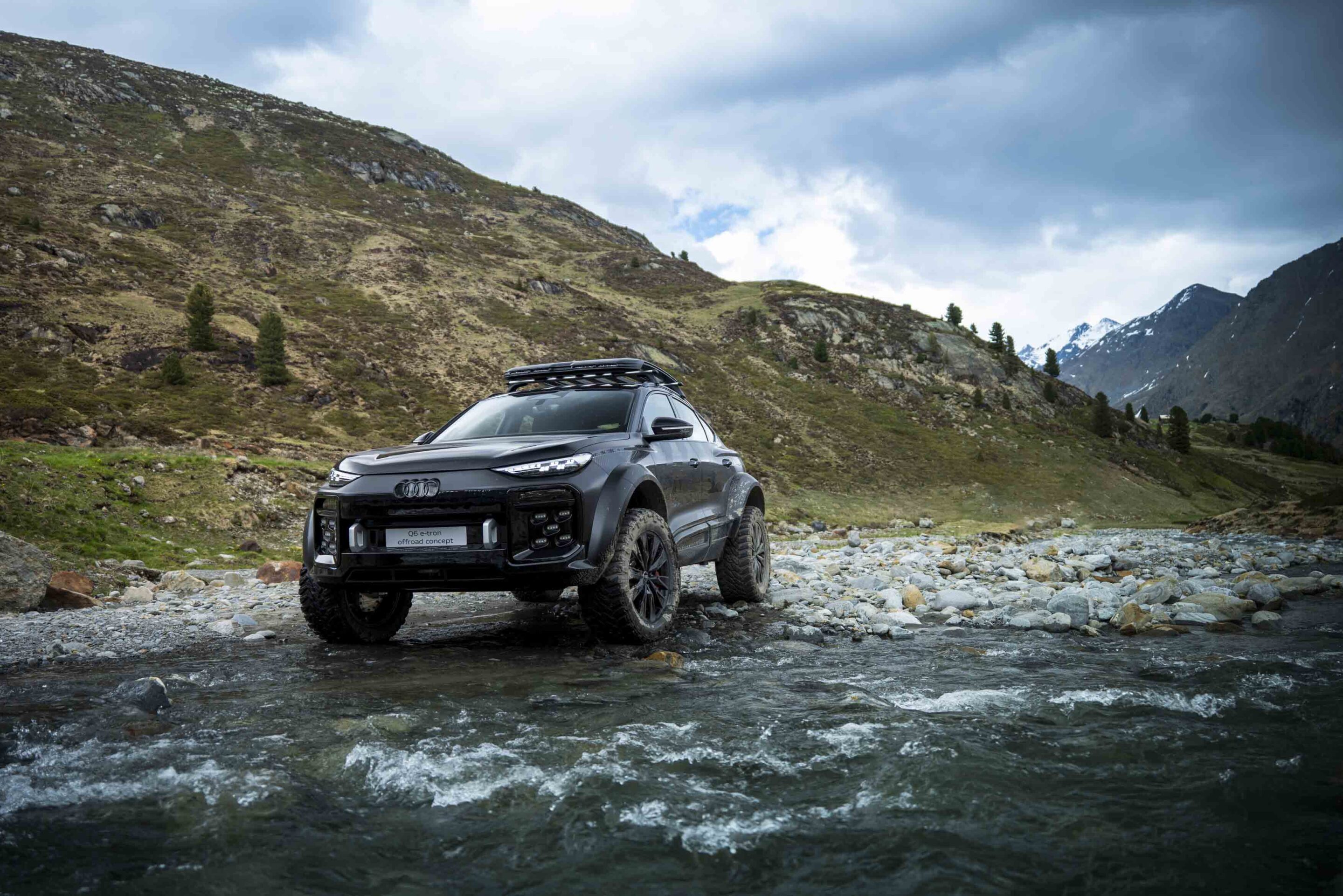
Speculation among industry observers suggests the SUV could combine a strong, boxy silhouette with features aimed at serious off-roaders, potentially including advanced traction systems, configurable drive modes, and even electrified powertrains.
Some insiders also think Audi could benefit from Volkswagen Group’s revived Scout brand in the USA, which is developing all-electric off-roaders. This might give Audi a head start on electrification and rugged capability without developing an entirely new platform from scratch.
At this stage, almost nothing is confirmed. Engines, pricing and production plans remain unknown, and Audi has not officially committed to bringing such a model to market. What is clear, however, is that a fully realised, premium 4×4 from Audi would place the brand in a rarefied segment alongside the Defender and G-Class.